Think of a piece of textile art you admire. Really see it in your mind’s eye. Picture the intricacy of the textures. The complexity of the patterns.
Do you feel daunted? Unable to fathom how to start building such beautiful textural effects? Such mesmerising areas of pattern?
Take a deep breath and dig a little deeper. Reverse engineer the artist’s process. Unpick the stitches used to create those layers of detail.
You might be surprised by what you find.
What at first appears technically complicated, might actually be deceptively simple.
How top textile artists build texture, pattern and line
In this article, six contemporary textile artists discuss how they use embroidery to create texture, pattern and line in their art. Each of them has a highly distinctive visual vocabulary and the ability to surprise the viewers of their work.
Yet they all use a similar, limited pallette of stitches in combination with a few other simple techniques.
They innovate through imagination and invention rather than through a wide range of elaborate processes.
By constantly experimenting and honing their voice, these six practitioners have uncovered very personal ways of speaking through their materials.
In the article Are you a textile technique addict? I argued that to take control of your process and develop a strong artistic identity, you should consider limiting the number of techniques you use.
My hope is that, after reading this article, you’ll feel inspired to put that theory into practice, knowing that the only barrier to innovation is your imagination!
Cas Holmes
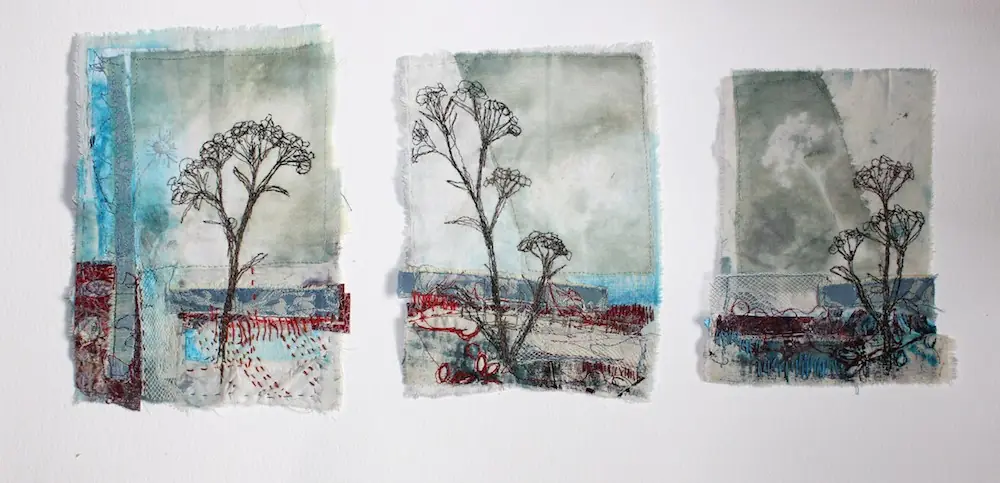
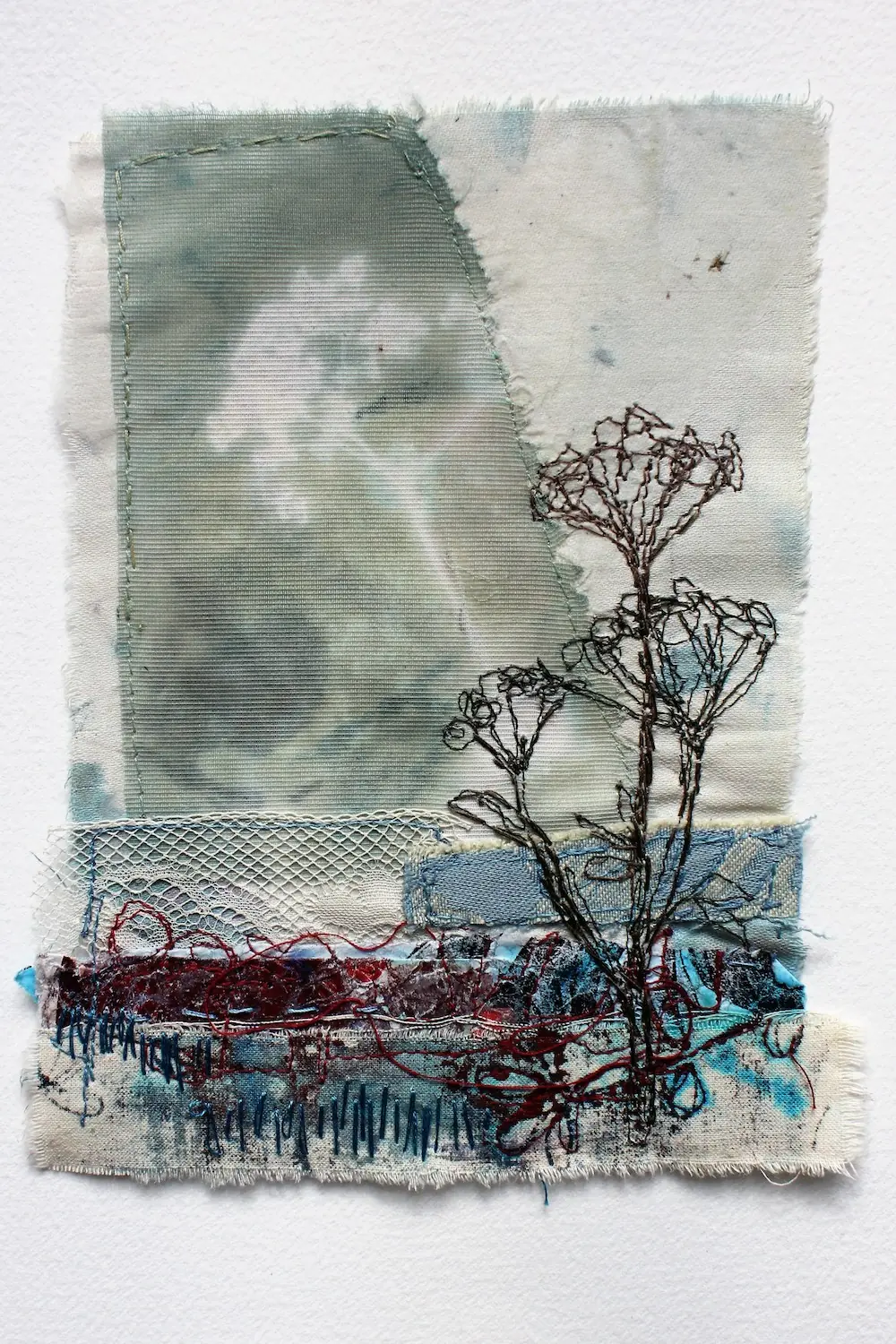
Extreme stitching
“I always had the fear of being separated and abandoned. The sewing is my attempt to keep things together and make things whole.” Louise Bourgeois
Cas Holmes: I am often asked if I use machine or hand stitch. In fact, I use both. Machine and hand stitched marks are as different as a charcoal pencil and a fine drawing pen and produce a wide variety of lines.
And you can exploit their differences. Densely worked stitch can provide textural interest. Applied in a more open and gestural way, stitch can give a sense of movement.
The sewing machine can be used as a mechanical ‘mark making tool’ in a process jokingly referred to by a technician at West Dean where I regularly teach, as ‘Extreme Stitching’.
Experimenting with a restricted stitch palette, consisting mostly of straight stitch, with perhaps seed stitch and French knots as extra, does not limit my application to develop line, texture, pattern and movement in a piece.
A stitched line can be used constructionally and visually to both hold cloth together and add additional colour and texture on the surface of a work.
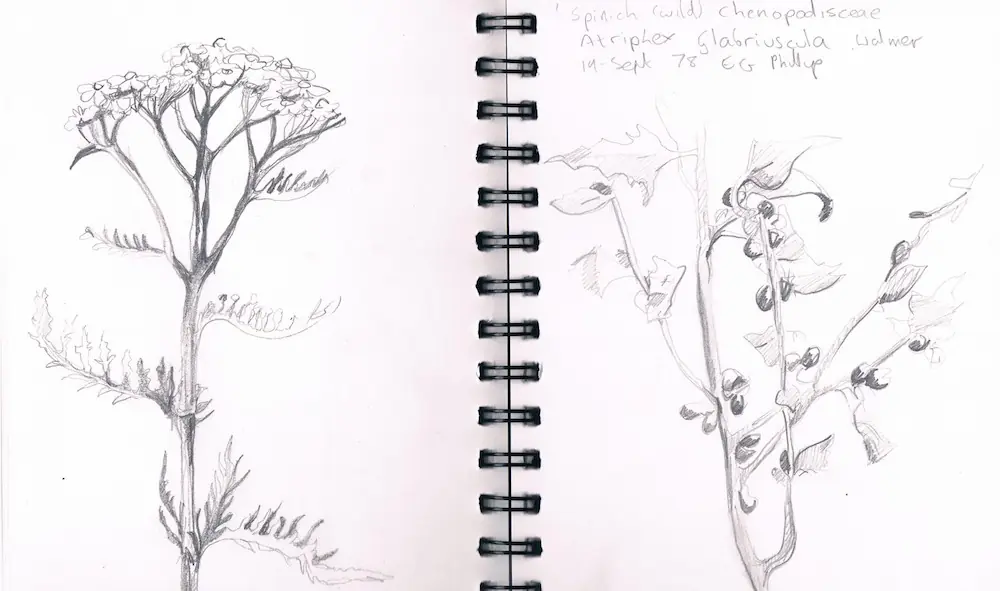
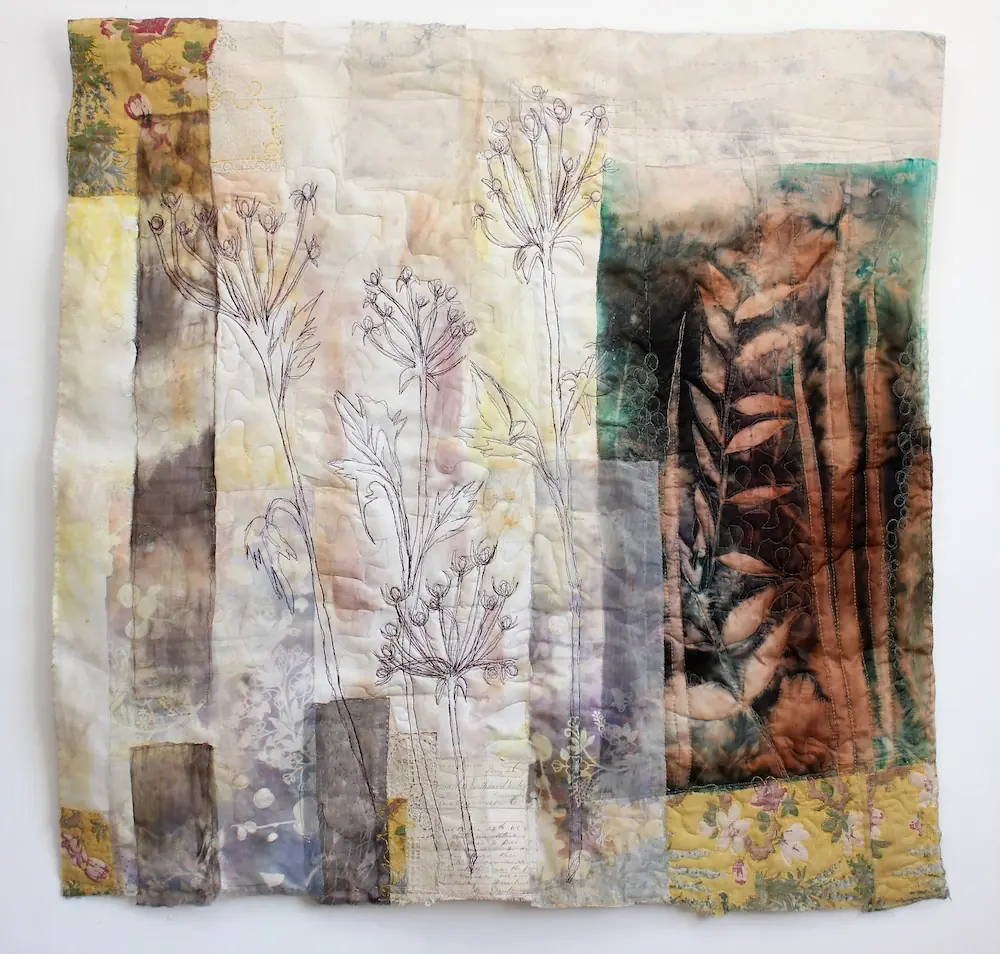
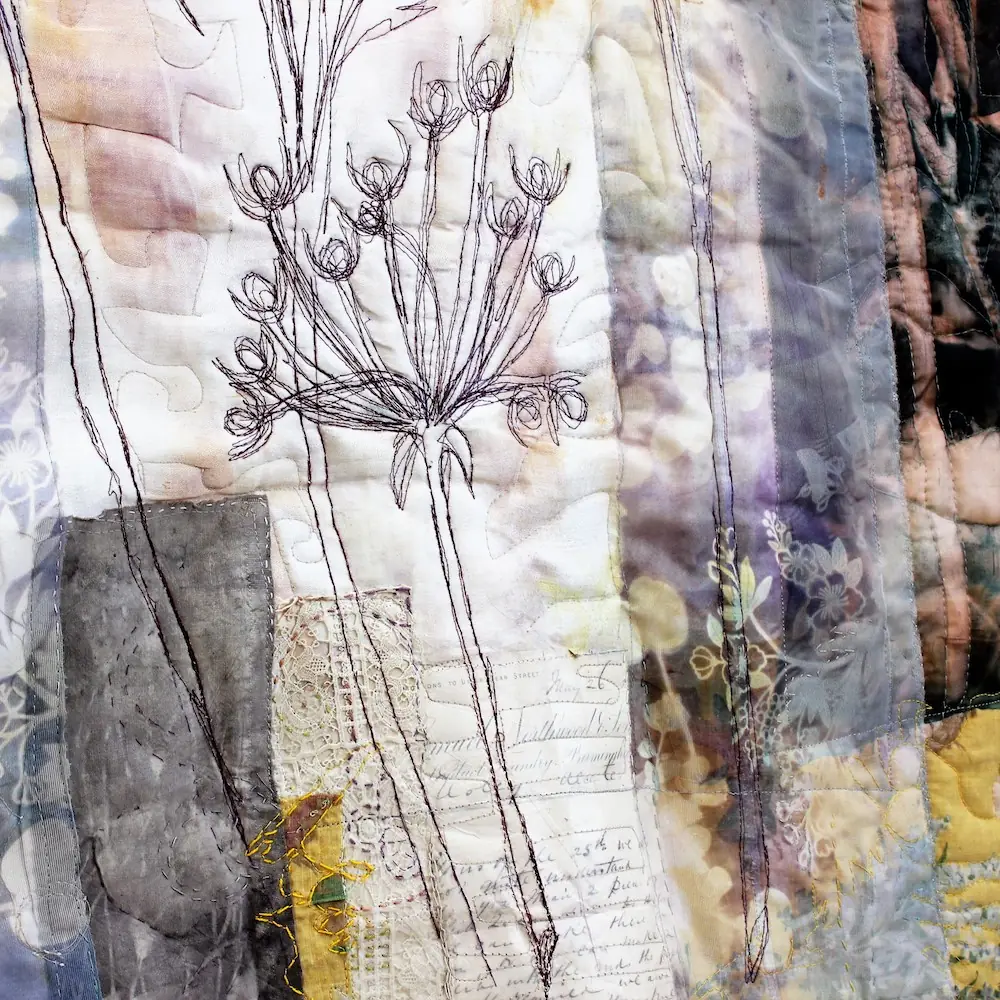
Exploiting marks
I like to work on smaller pieces as I develop bigger projects and it is on these smaller pieces that I will exploit and play with marks.
My drawing and sketches are a constant stimulation and resource. They are not there to be copied but rather as means of reference and reflection.
My recent publication Stitch Stories (Batsford 2015) contains many references to the application of stitch and I am currently writing my fourth book for Batsford.
Website: casholmes.wordpress.com
Read TextileArtist.org’s interview with Cas
Emily Jo Gibbs
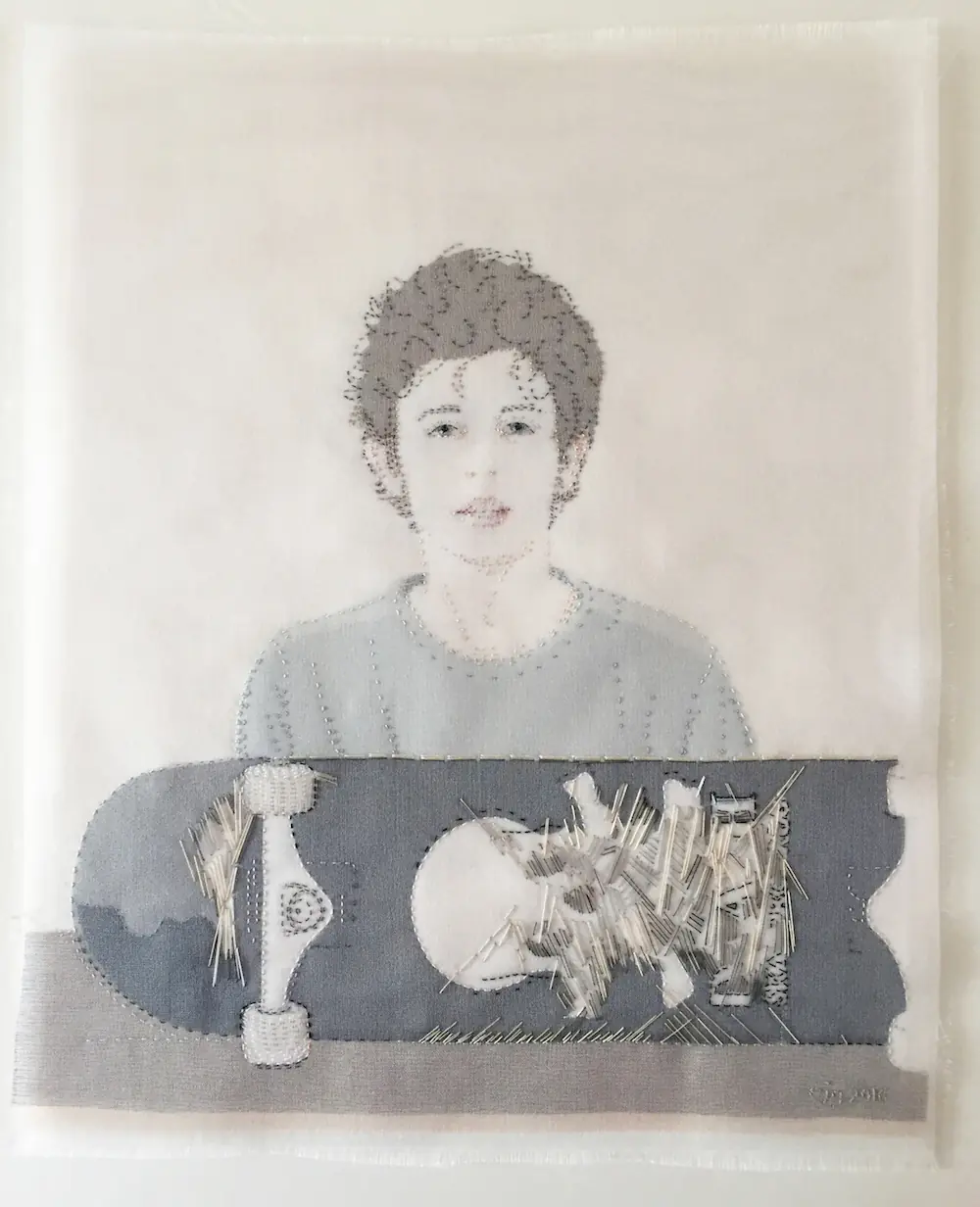
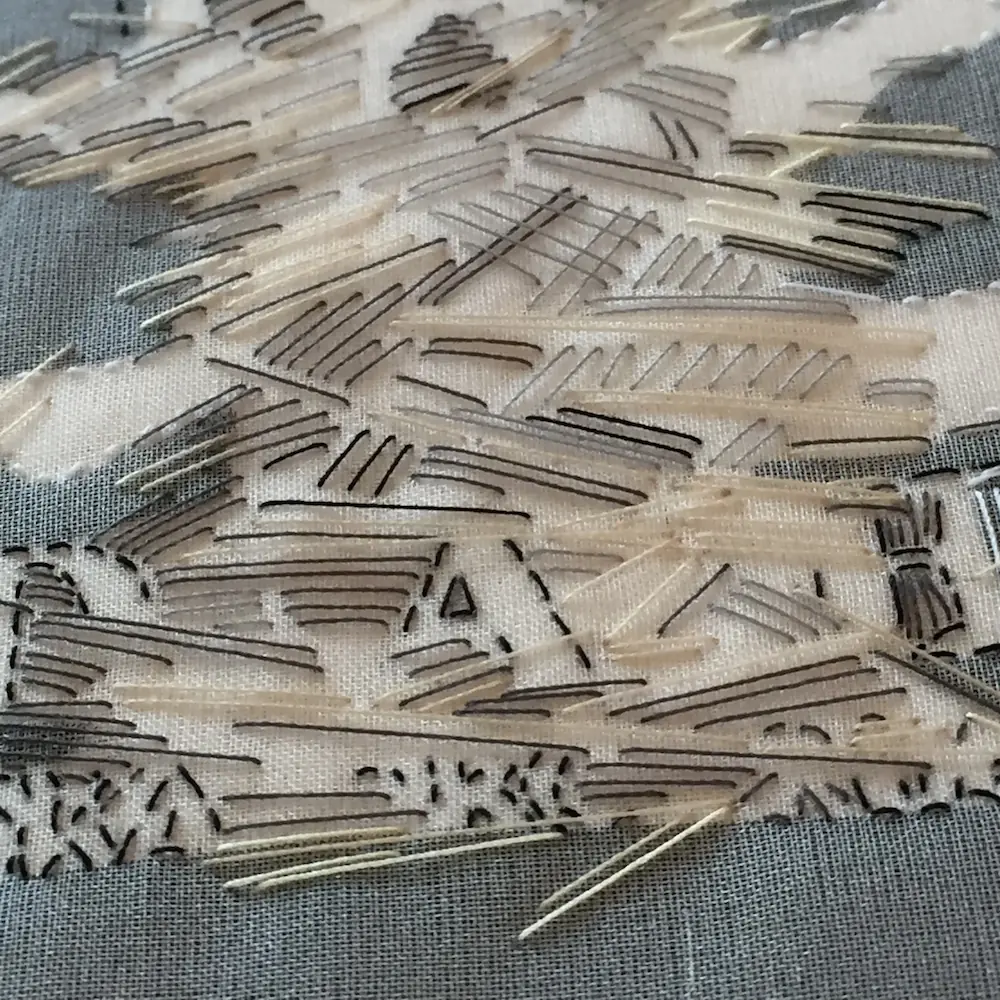
A modest taste in stitches
Emily Jo Gibbs: In my work, I’m always trying to distil or simplify the image as much as possible. I really enjoy the flat nature and clean shapes that can be achieved cutting and layering silk organza. I then use stitching to highlight areas and join layers.
My taste in stitches is quite modest; I love a French knot but otherwise, I’m all about stab stitching, running stitch, cross stitch and simply using the thread to draw lines.
I wasn’t sure at first how I was going to tackle Peter’s skateboard (pictured above).
The technique I use, cutting shapes from pieces or organza and layering them, requires a surprising number of decisions about what to have as flat colour and what to have as stitch.
In the end, I cut out the whole scuffed area of the skateboard and built up the scuffs with stitches. I also used a little bit of running stitch to indicate the lettering that hadn’t been worn away.
I like a tight colour palette and I chose generally not to crisscross the stitches as I wanted it to look graphic and intentional, not messy.
When Violet came to sit for her portrait (pictured below) she put on her shirt covered with tiny scull and cross bones especially. It would have been a much longer project if I had interpreted the pattern literally. Instead, I hinted at the pattern with white cross stitches and used dark toned threads to indicate the folds and construction of the shirt. I feel the folds in the shirt really convey how Violet is sitting and add to the likeness.
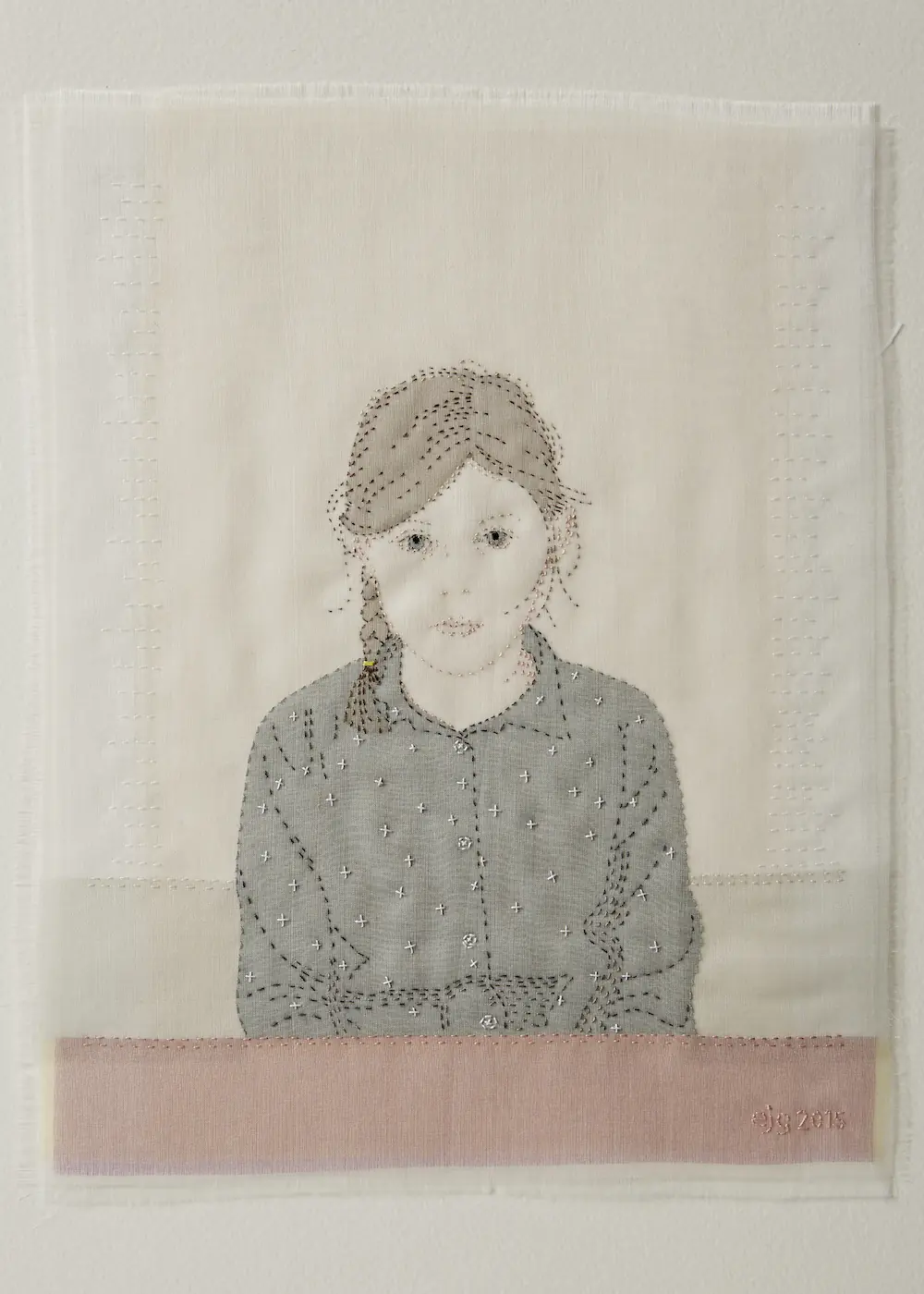
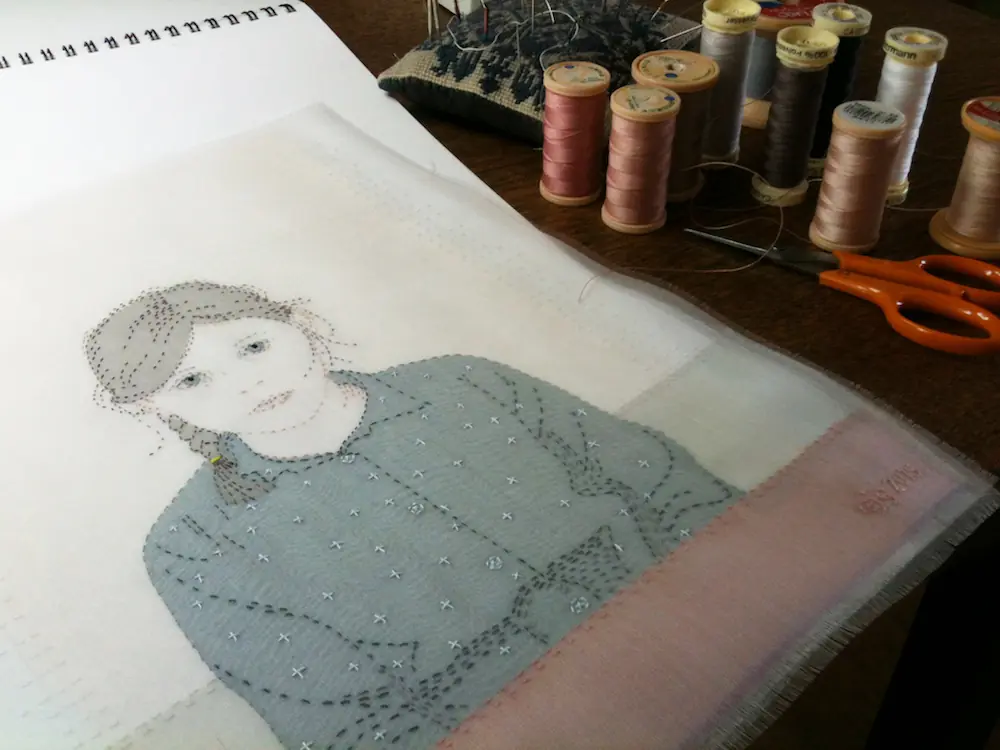
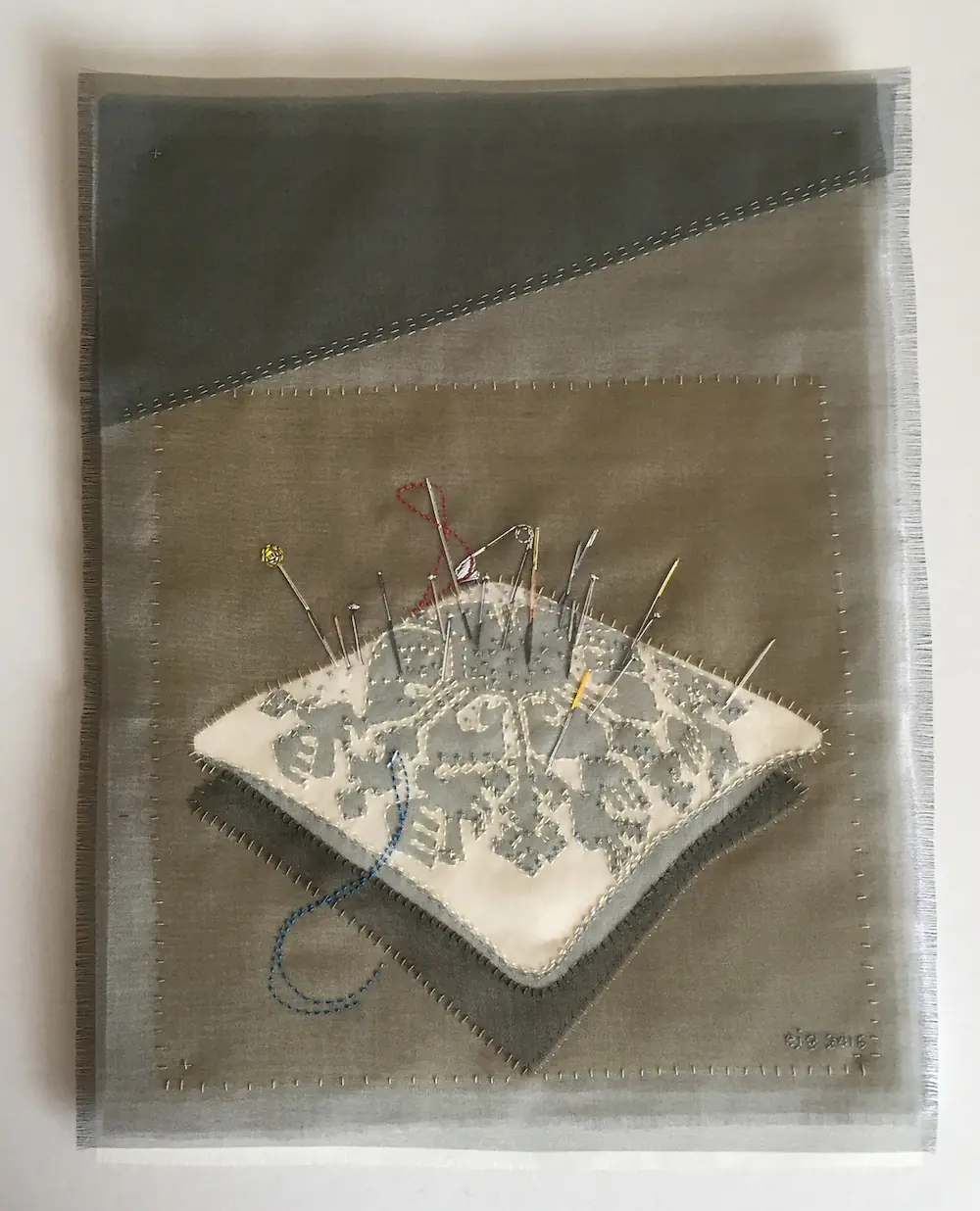
The pattern on my pincushion portrait (pictured above) is cut from a piece of blue/grey organza, which is laid underneath a piece of cream organza. It is secured in place by a cream running stitch. I have then used a few cross stitches to accentuate the pattern and also indicate the construction of the actual pincushion, which is tiny needlepoint.
When I first made this piece I used a much darker blue thread for the cross stitches but it took away the very two tone nature of the piece so I unpicked them and started again.
Website: emilyjogibbs.co.uk
Read TextileArtist.org’s interview with Emily Jo
Richard McVetis
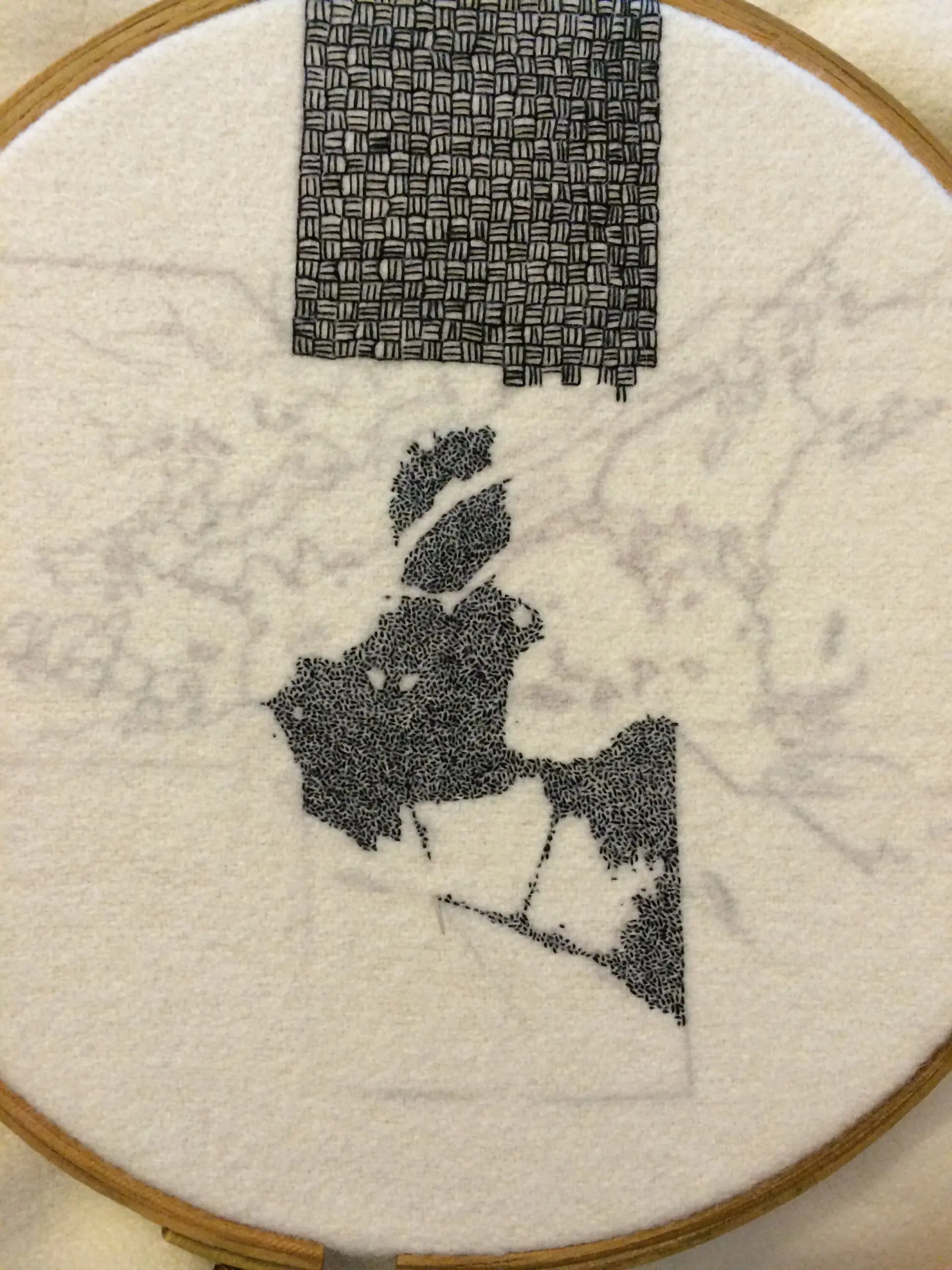
A focus on content and concept
Richard McVetis: As a child I would create entire worlds on the back pages of my school exercise book, building and destroying futuristic cities with a black ballpoint pen.
I found this method of drawing with black ink very satisfying and my interest in this continued right through to college; I love the idea that with pen and ink you are able to explore and create different subtleties in texture.
Embroidery for me is an extension of this exploration of surface through rendering. Substituting the ink for thread and the paper for fabric.
The simplicity of the stitches I use means that I’m not distracted so much by technique. Instead, I try to focus on content and concept. But really this has only been possible as I have become fluent in my mark making.
Seeding stitch has become my go-to technique. Its control and versatility has meant I’m able to utilise it across many projects as both a drawing technique and as a conceptual component.
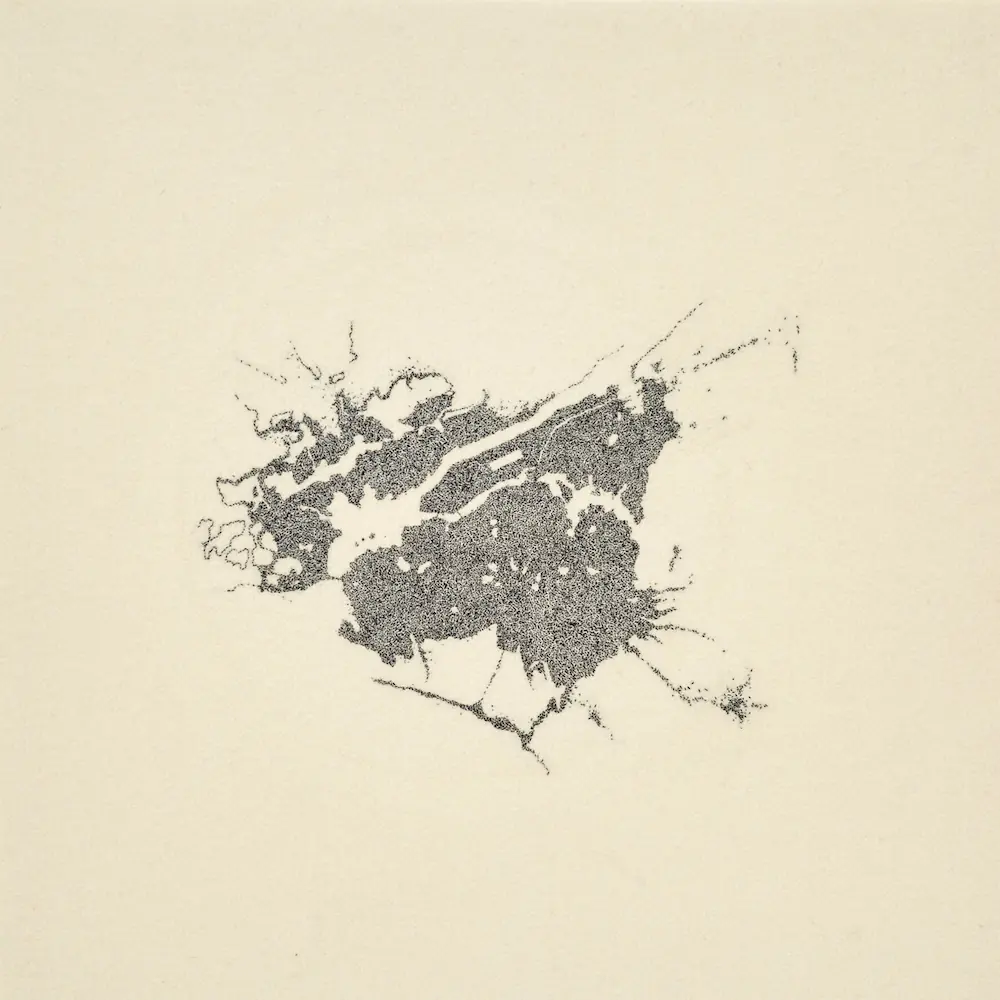
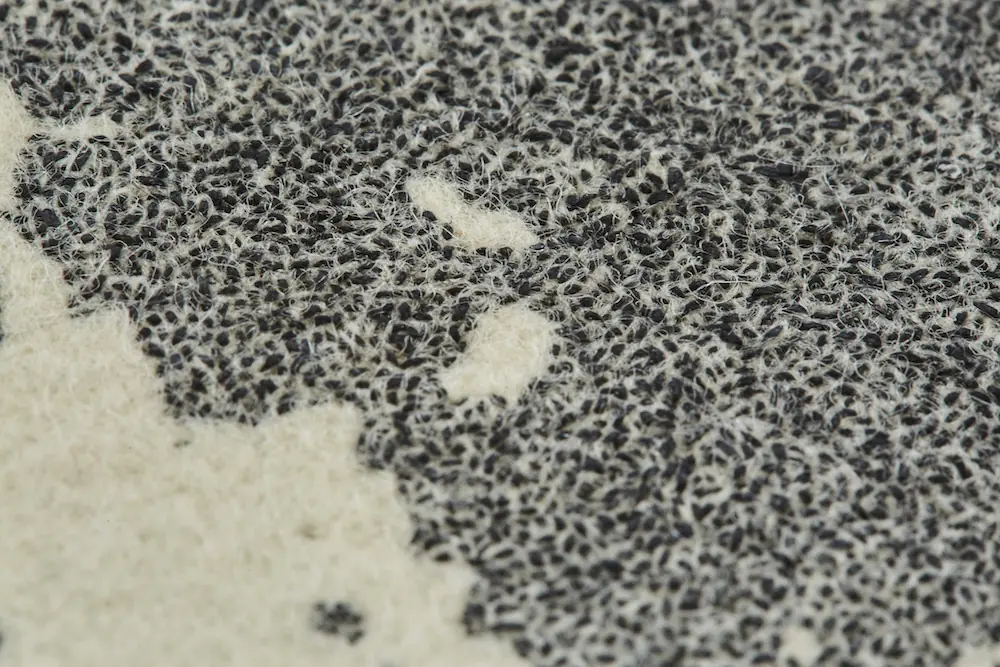
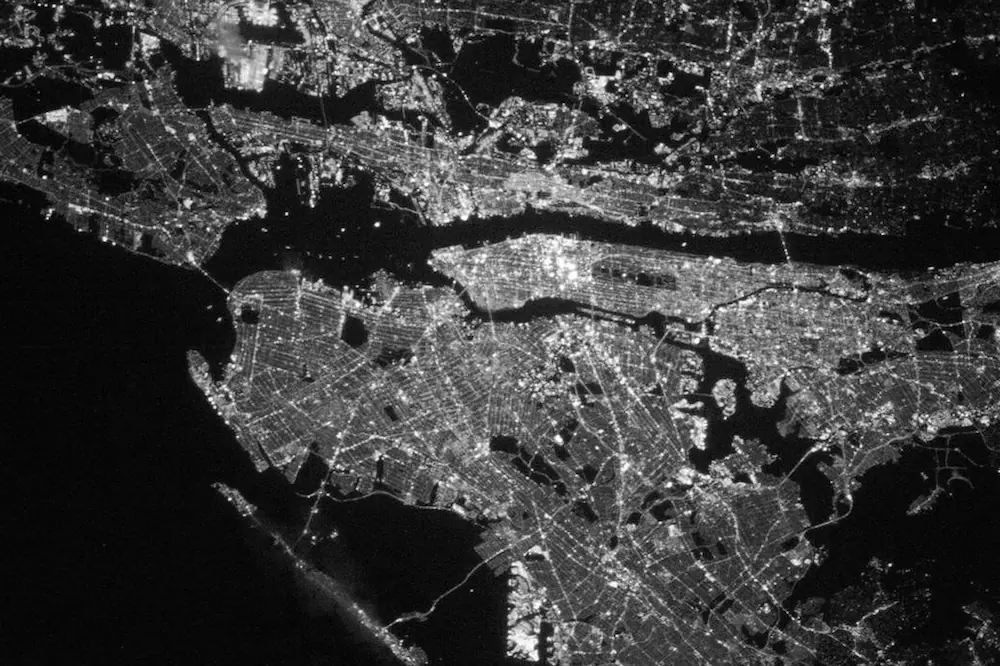
Minute detail and intricate patterns
My ‘Light Abstraction’ series (pictured above) uses seeding stitch to draw aerial light patterns of cities at night, worked from NASA images and abstracted so that each stitch represents an individual light.
The stitches are sewn one at a time, allowing me to control and contemplate. By slowing the process down, I’m able to play with the tension of thread, for example pulling the thread tighter creates smaller stitches that sit closer to the fabric structure. This gives the stitch an almost sketch-like quality; gradients of dots that look to have been formed from lots of different coloured threads actually use just one.
The scale of seeding stitch also allows for minute detail and intricate patterns to be drawn easily.
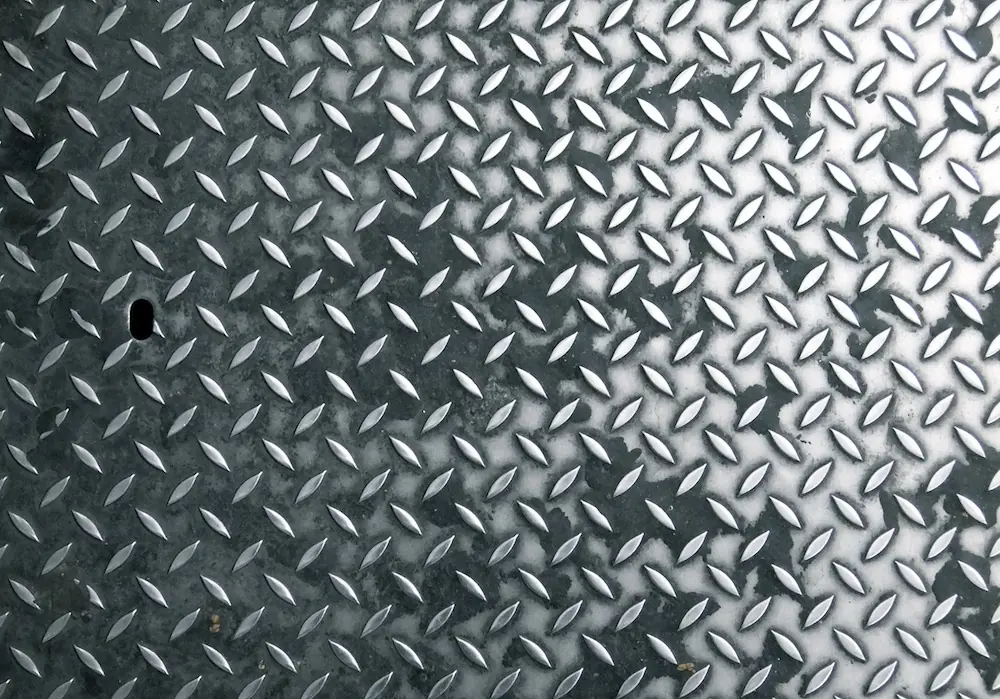
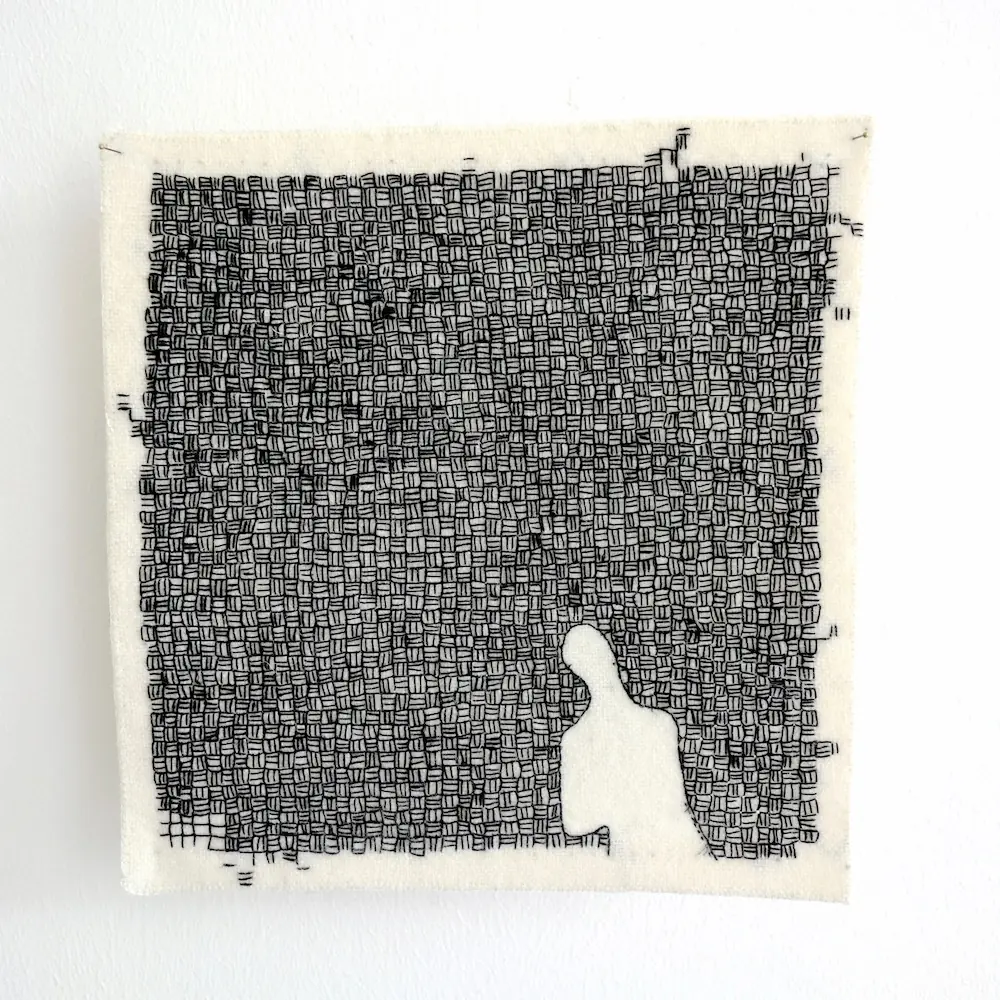
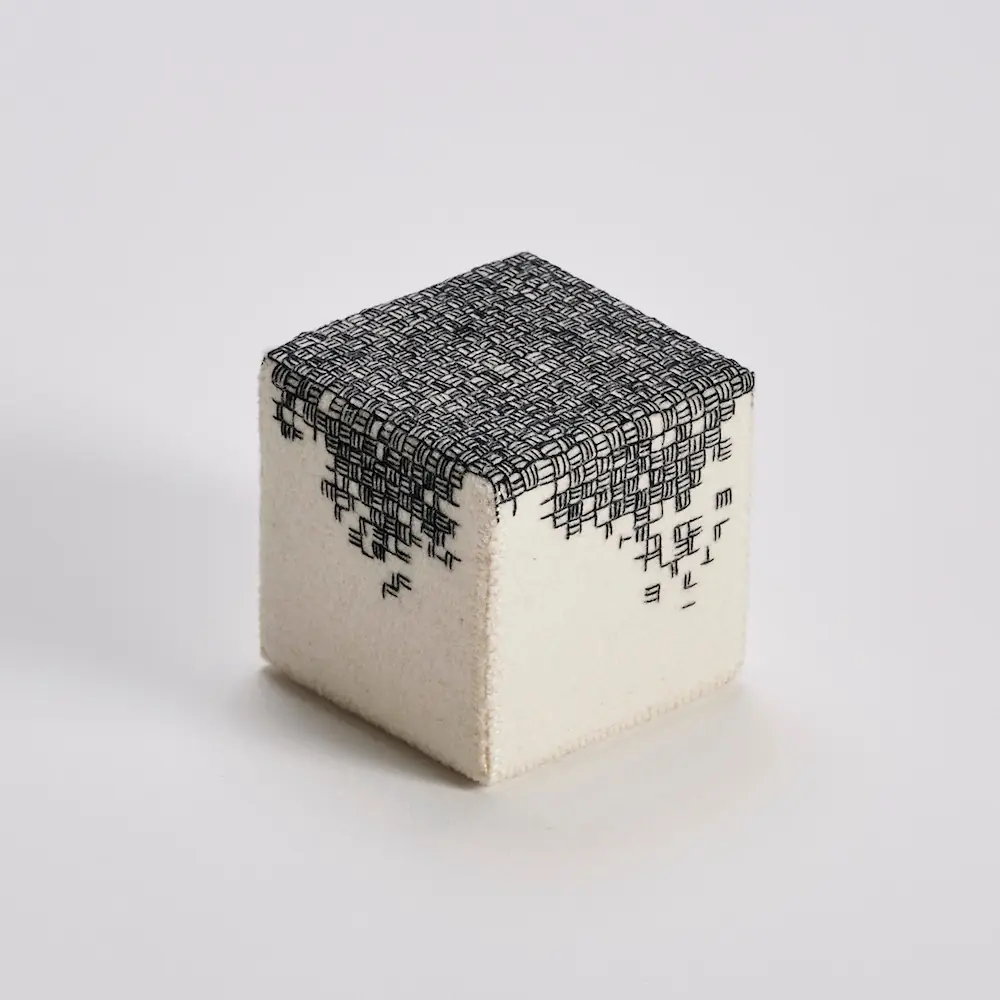
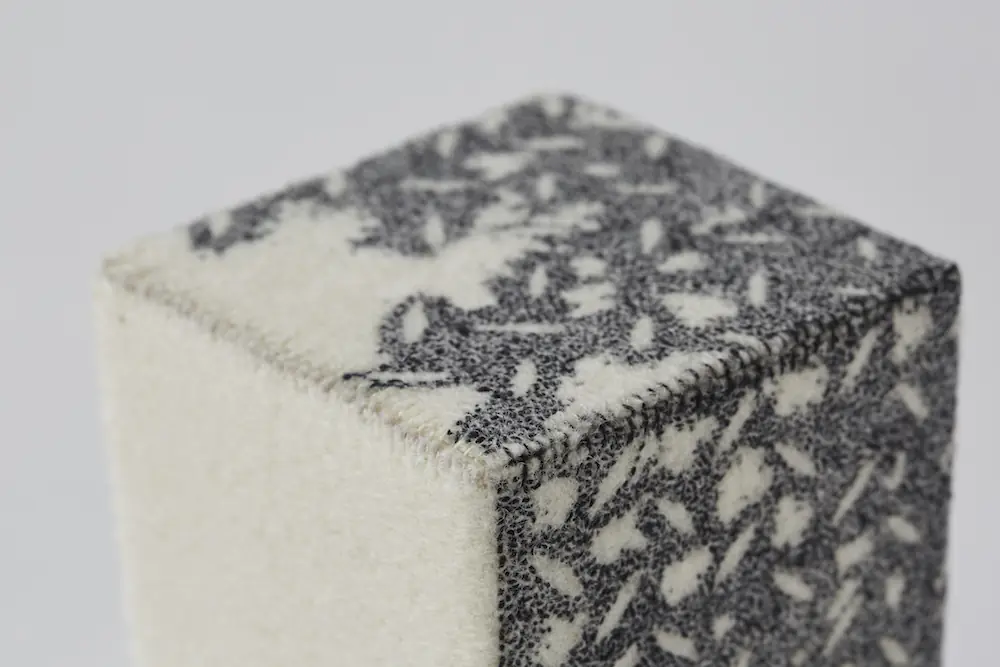
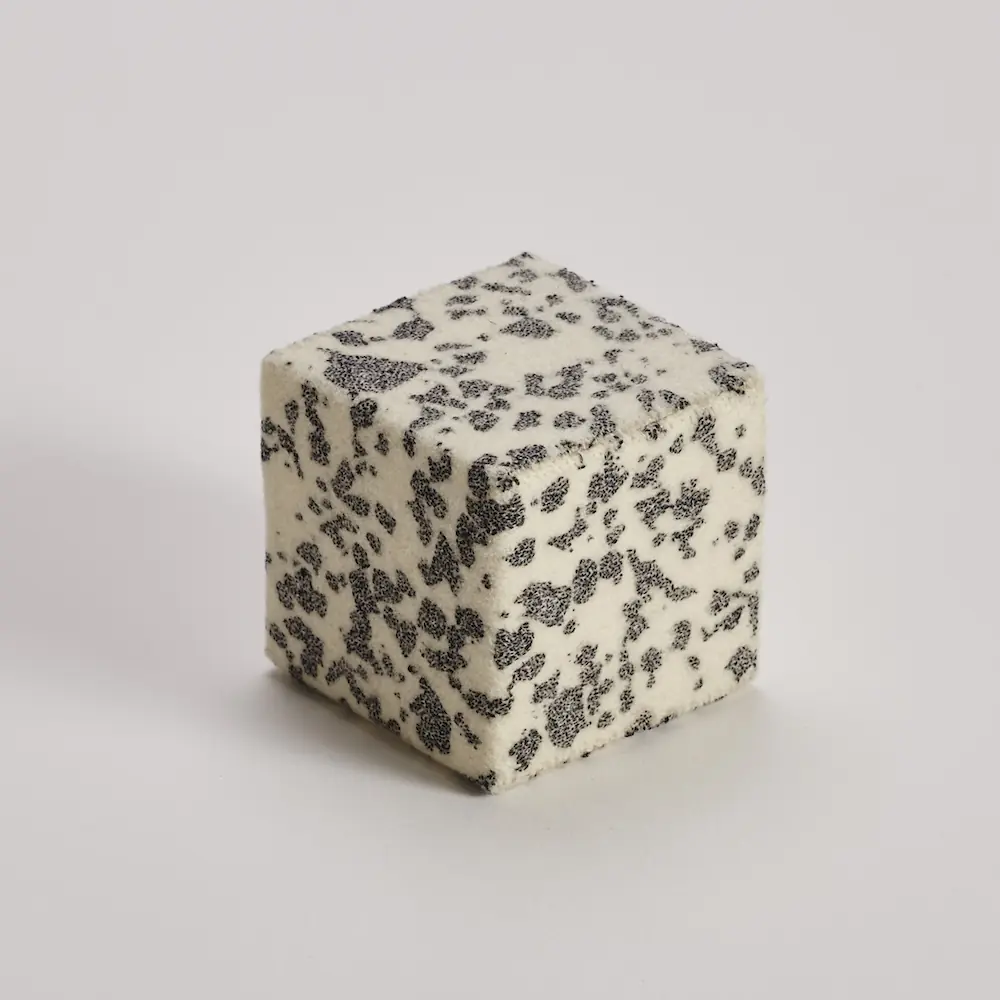
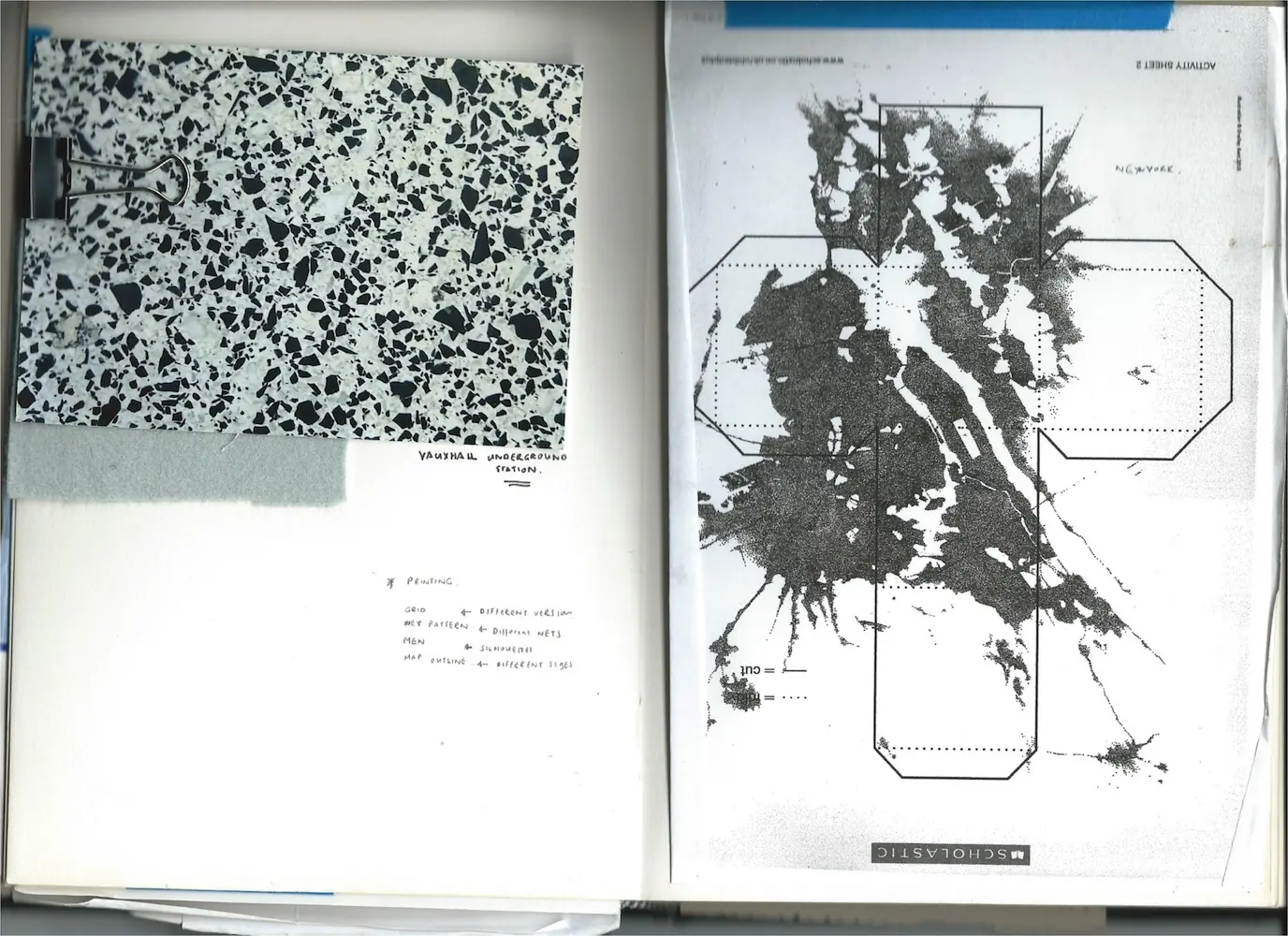
Many of the patterns that inspire me are part of your every day; the metal tread of a station entrance or the shadow created by the morning sunlight. These moments are punctuations of time; slowing me down in what is quite a fast paced way of life.
Through embroidery, I try to capture these. The embroidered cubes, the compositions, constellations and arrangements I create directly reference the urban grid and my transient relationship to the built environment.
Both ‘Five o’clock Shadow’ and ‘Units of Time’ are meditations on time; moments made static by the slowness of process. When I see these patterns I immediately begin to translate them into marks that I can draw with stitch.
In ‘Five o’clock shadow’ & ’29-59’ (both pictured above) I wanted to capture the geometric structure of parquet floor. Using straight stitch I was able to show this order but with subtle variation and quality only made possible through hand stitch.
’50-29’ & ’35-56’ (both pictured above) record transient moments from my daily commute in London; each cube is a sketch of time and location. Drawn using seeding stitch to create the negative of a space to represent a pattern.
Website: richardmcvetis.co.uk
Read TextileArtist.org’s interview with Richard
Evelin Kasikov
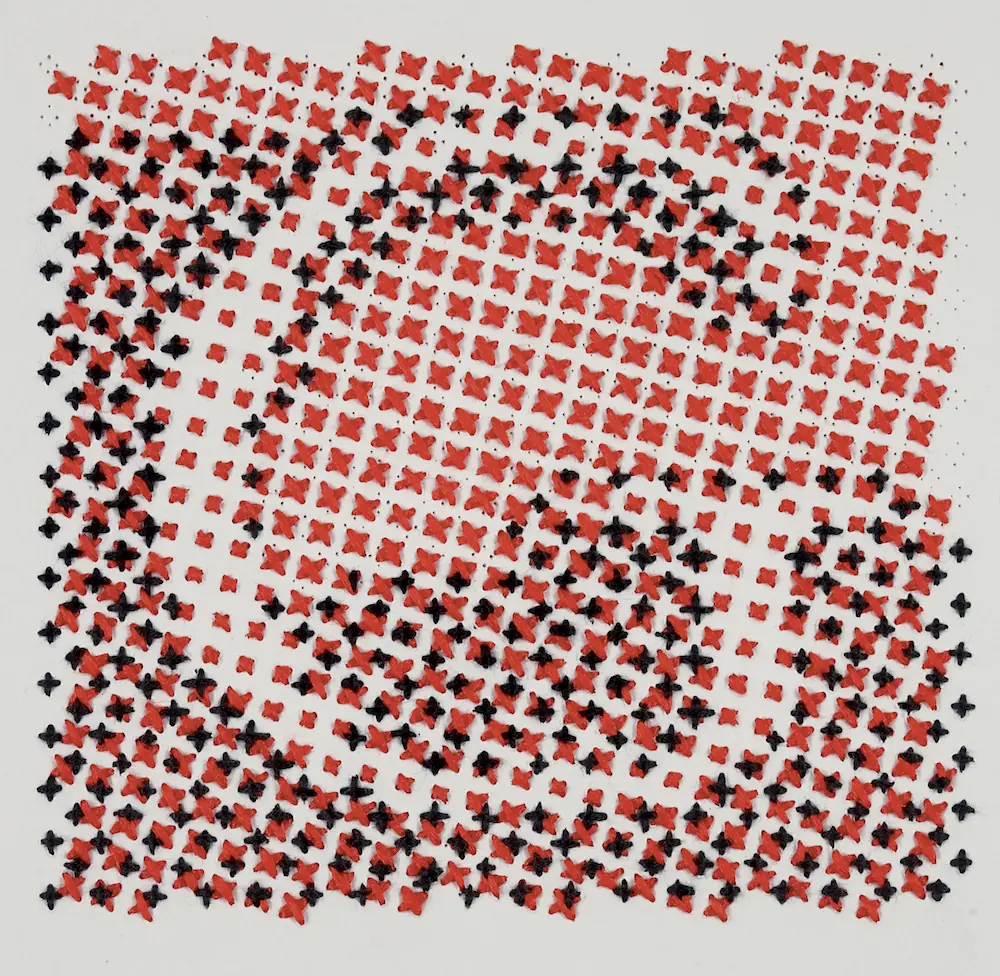
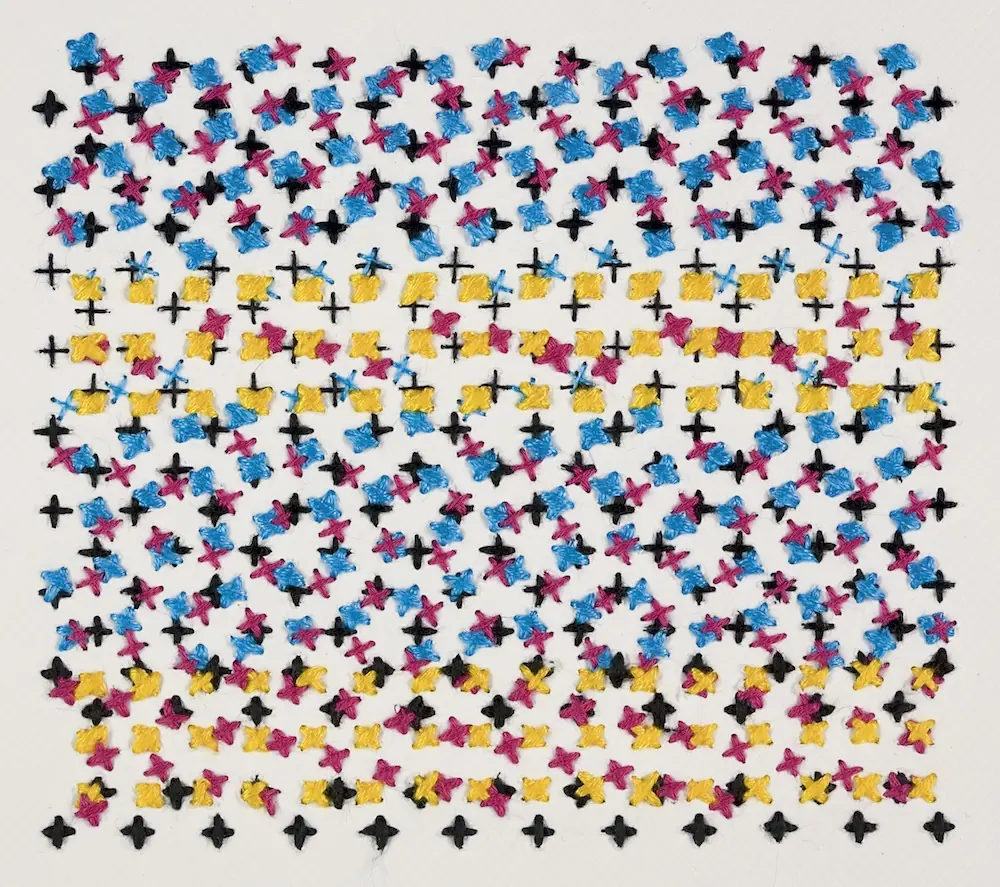
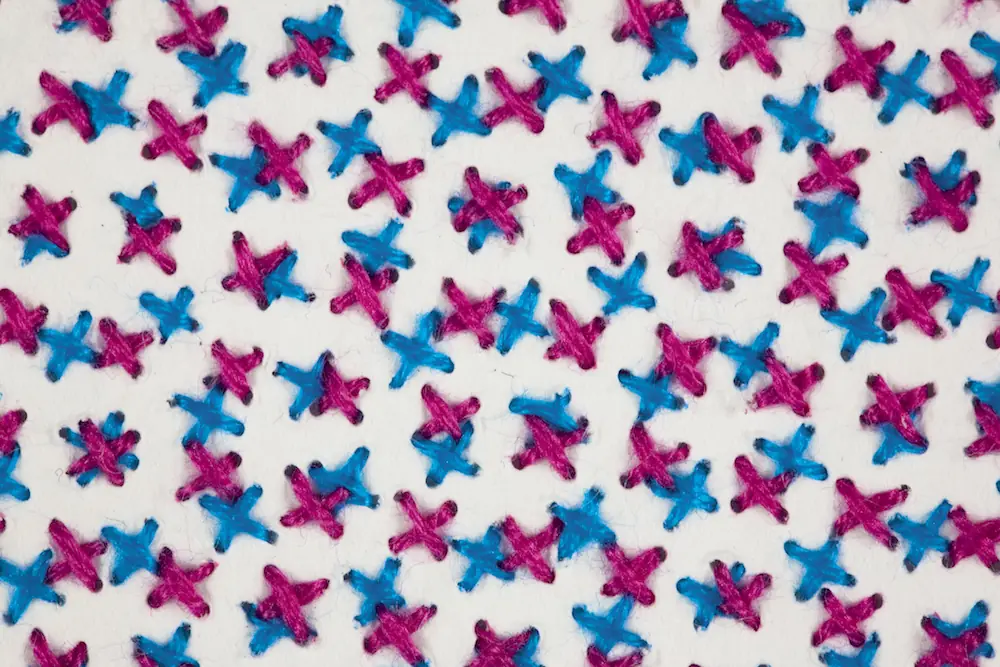
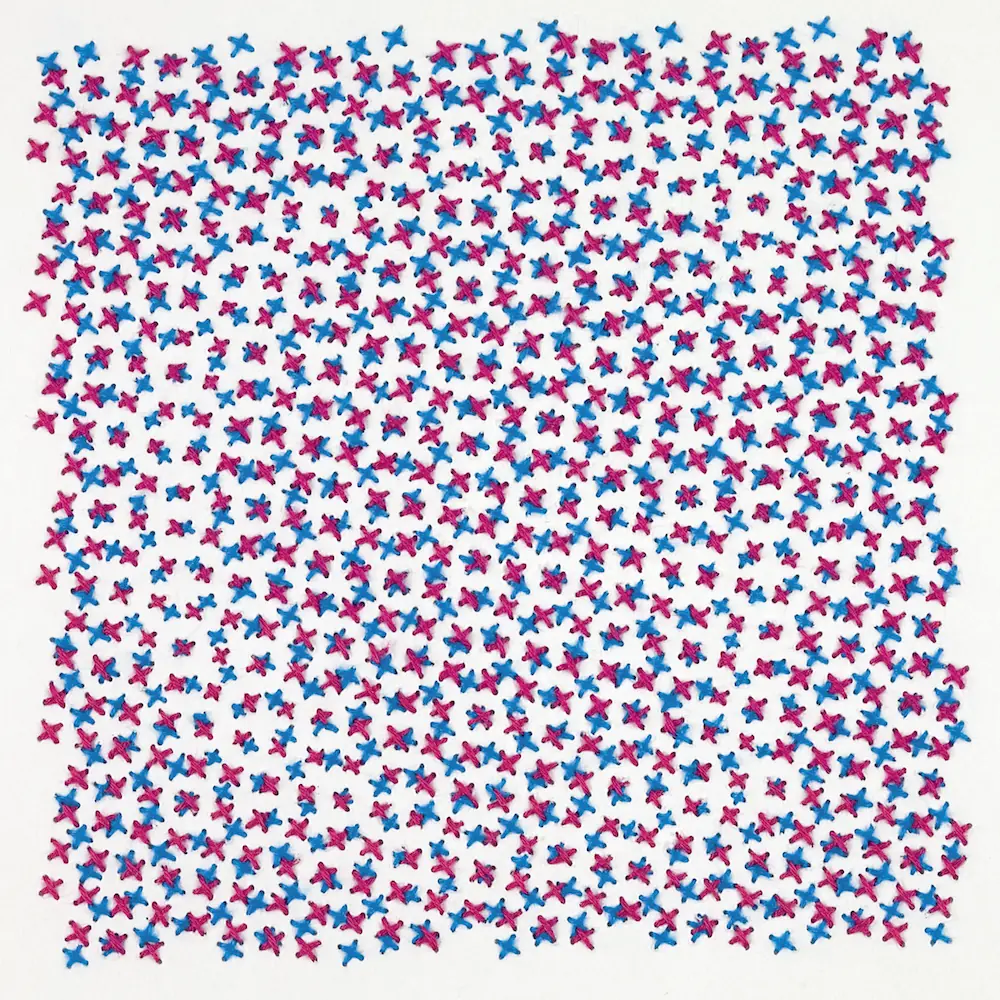
Halftone patterns
Evelin Kasikov: These are my very first experiments with stitched patterns from 2007. Having a background in both fine art and graphic design I was interested in crossovers between these disciplines and craft.
I have always had an interest in handmade and tactile aspects of design so, whilst I was studying at Central Saint Martins, I started to experiment with embroidery in a graphic design context.
These patterns are based on the idea of halftone screens. In print, the image is made of tiny halftone dots. I started by enlarging this pattern and turned the dots to crosses; that’s how I came to use cross-stitch embroidery in my work. By overlaying and rotating the screens, endless patterns can be created.
I also wanted to see if different colours could be created with thread in a similar way to ink and the result was exactly what I hoped for. When you look at the detail of Duotone (pictured above) you can see only crosses but when you look at the full image (also pictured above), overlaid blue and magenta crosses create purple colour.
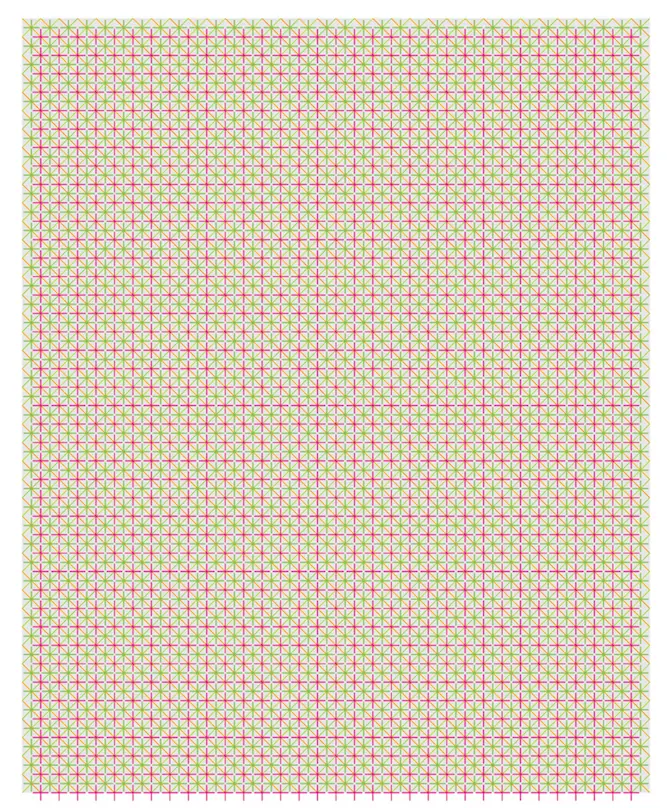
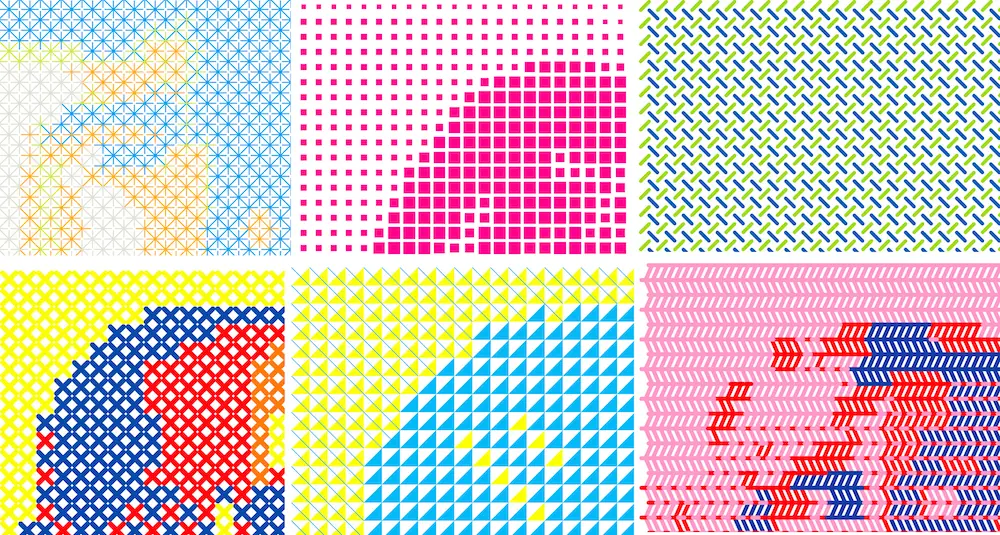

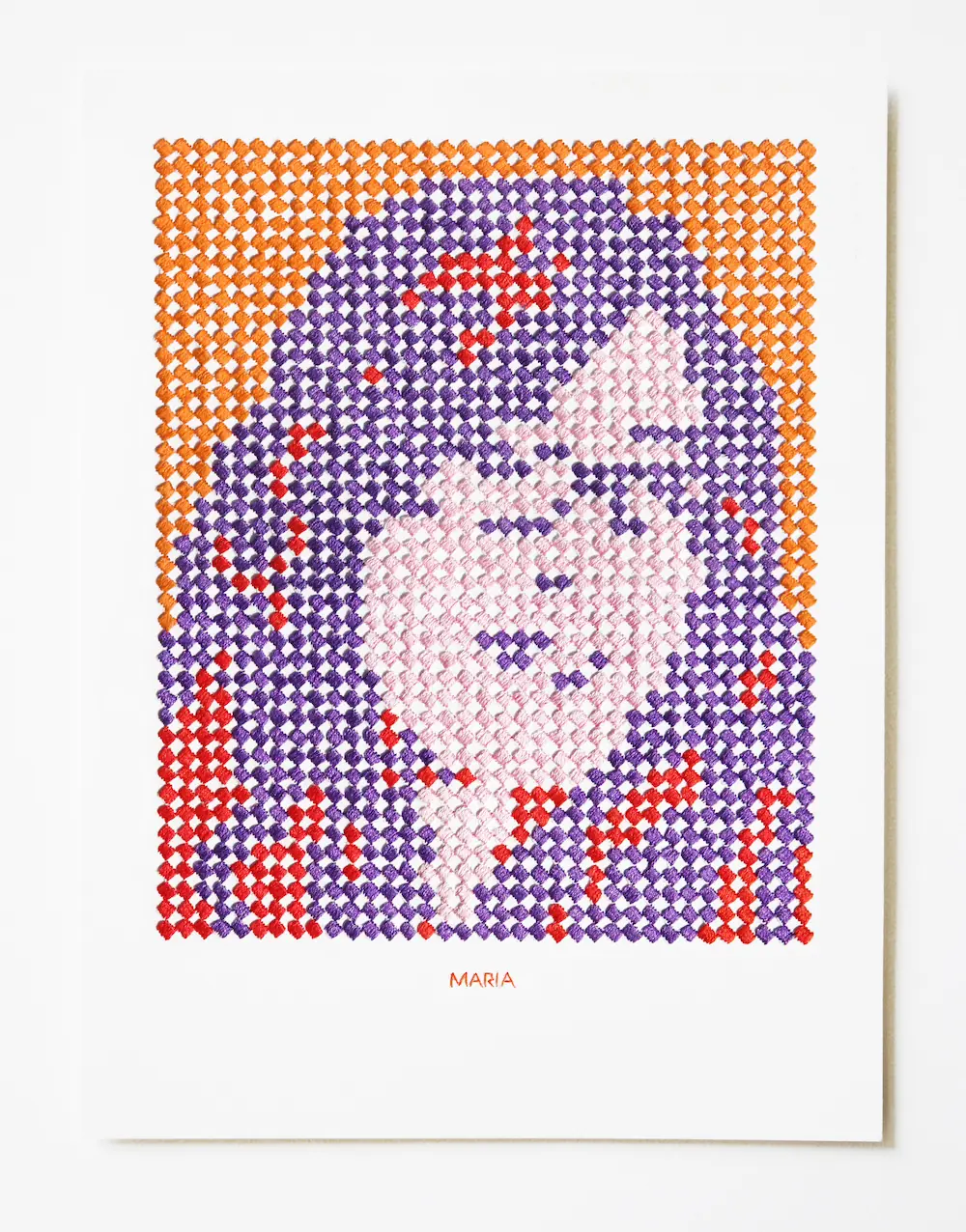
Portrait patterns
In 2011 I started a stitch portrait project.
I set myself a task of creating 12 different patterns based on the same grid system. On that grid, I used a variety of elements: half and full crosses, dots, squares and lines.
These pattern pieces became building blocks for constructing portraits of people.
It was not always a quick and straightforward process. Sometimes achieving a good likeness on a fixed grid took many rounds of tests, as you can see in the tests for Maria’s portrait (pictured above).
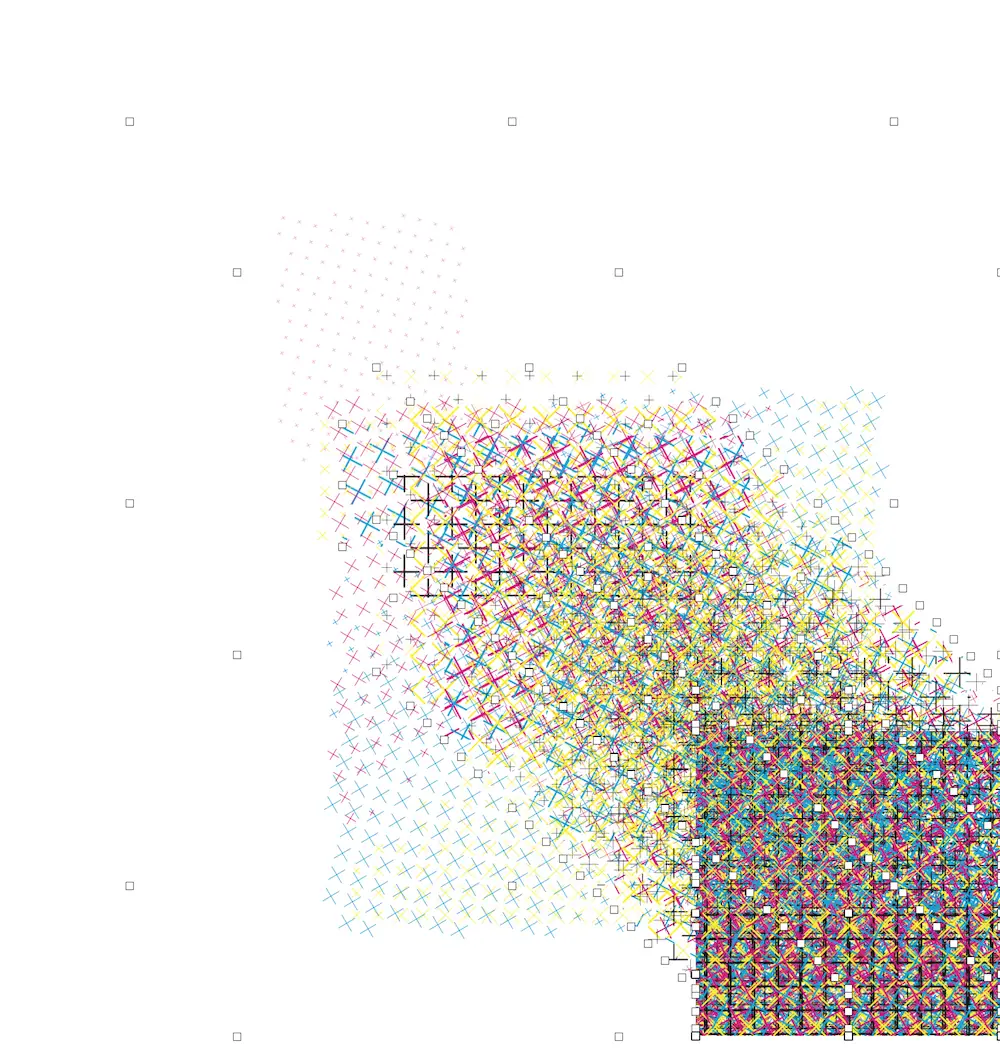
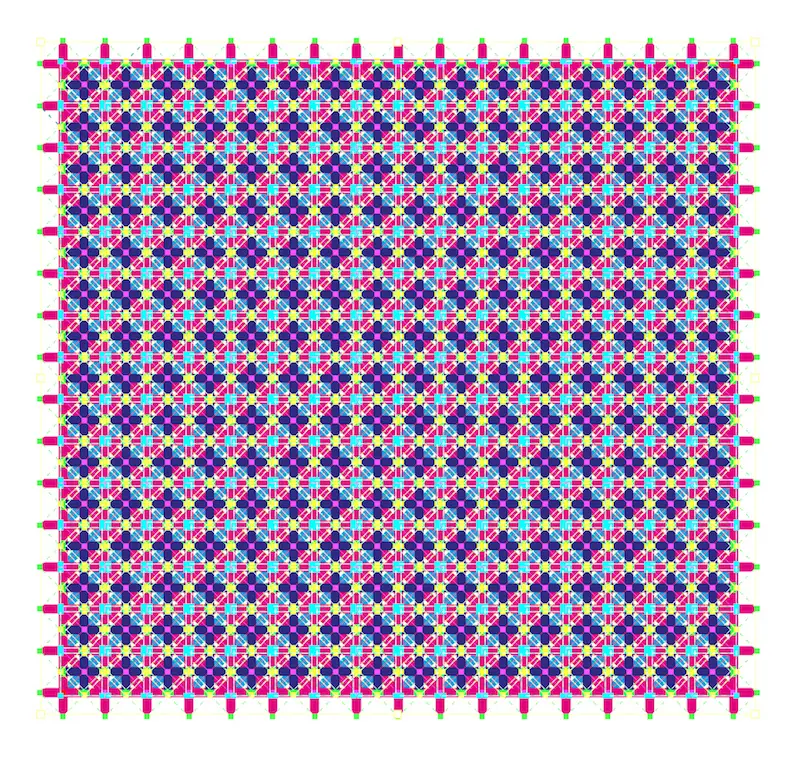
Process pattern experiments
These are my work in progress experiments with pattern. My inspiration tends to come from computer graphics and tech mostly! I keep a folder on my desktop where I collect screenshots of various software glitches if and when they happen. It might be that Google images are rendered as colour boxes because of slow internet connection. Or it might be a corrupt app that creates a wonderful glitch pattern (before I press force quit).
I find beauty and order in these images, and sooner or later these patterns feedback to my work.
Website: evelinkasikov.com
Read TextileArtist.org’s interview with Evelin
Hilary Ellis
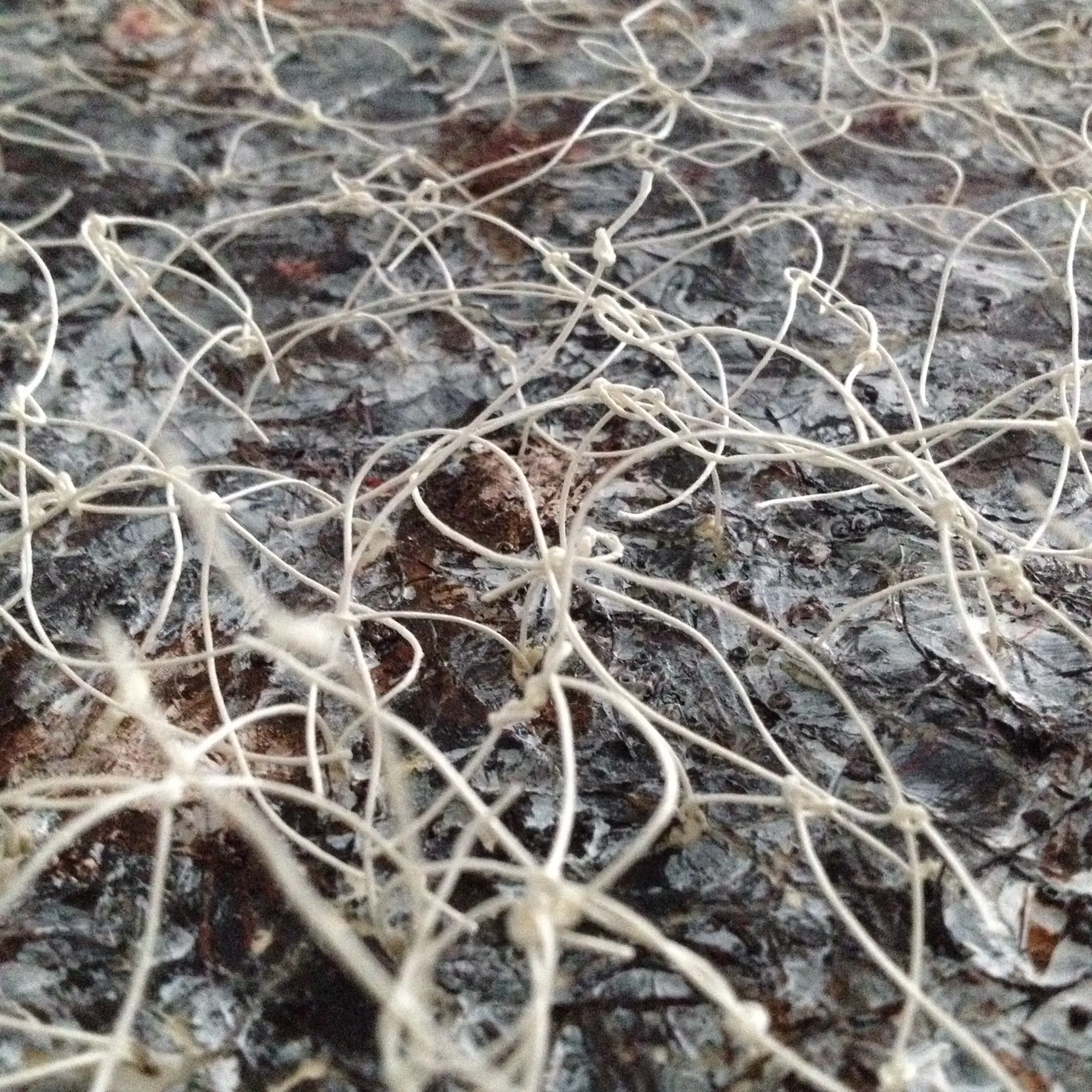
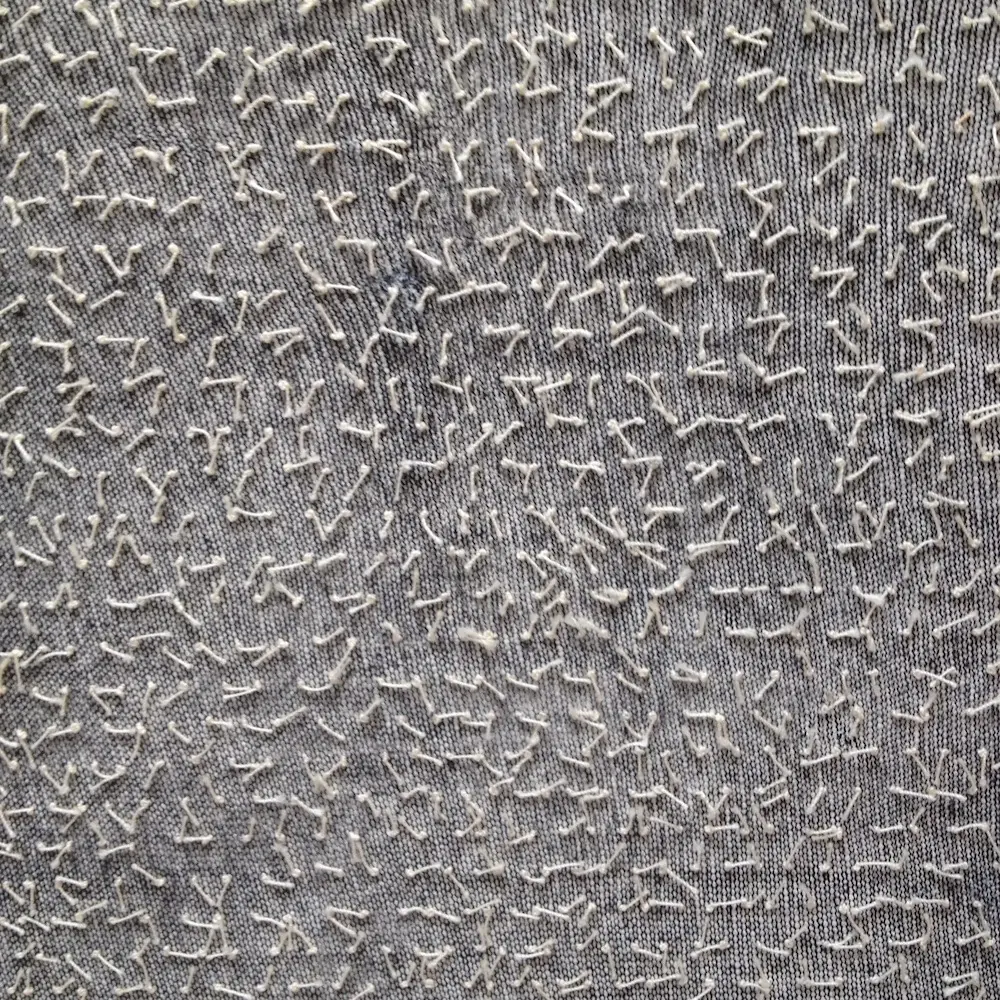
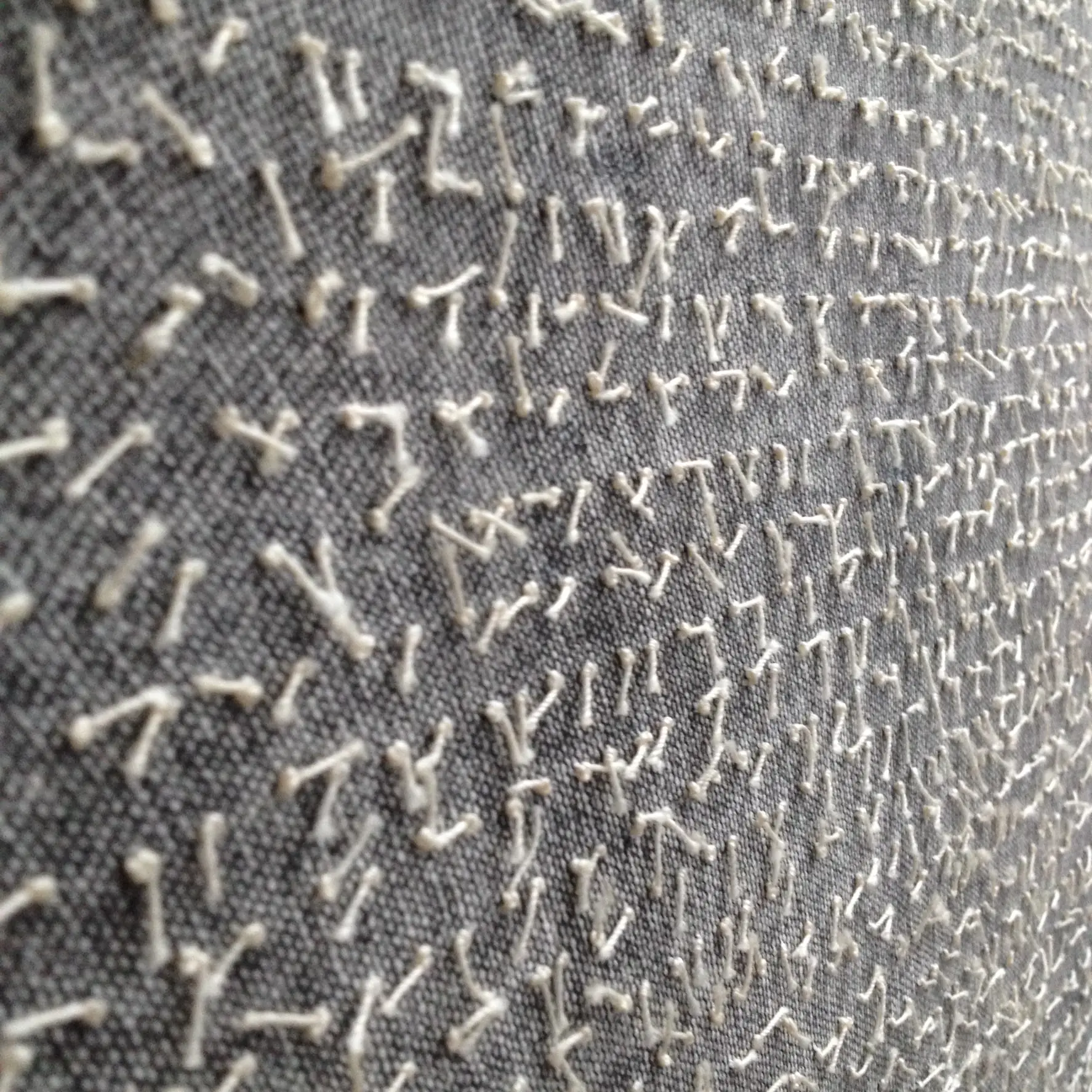
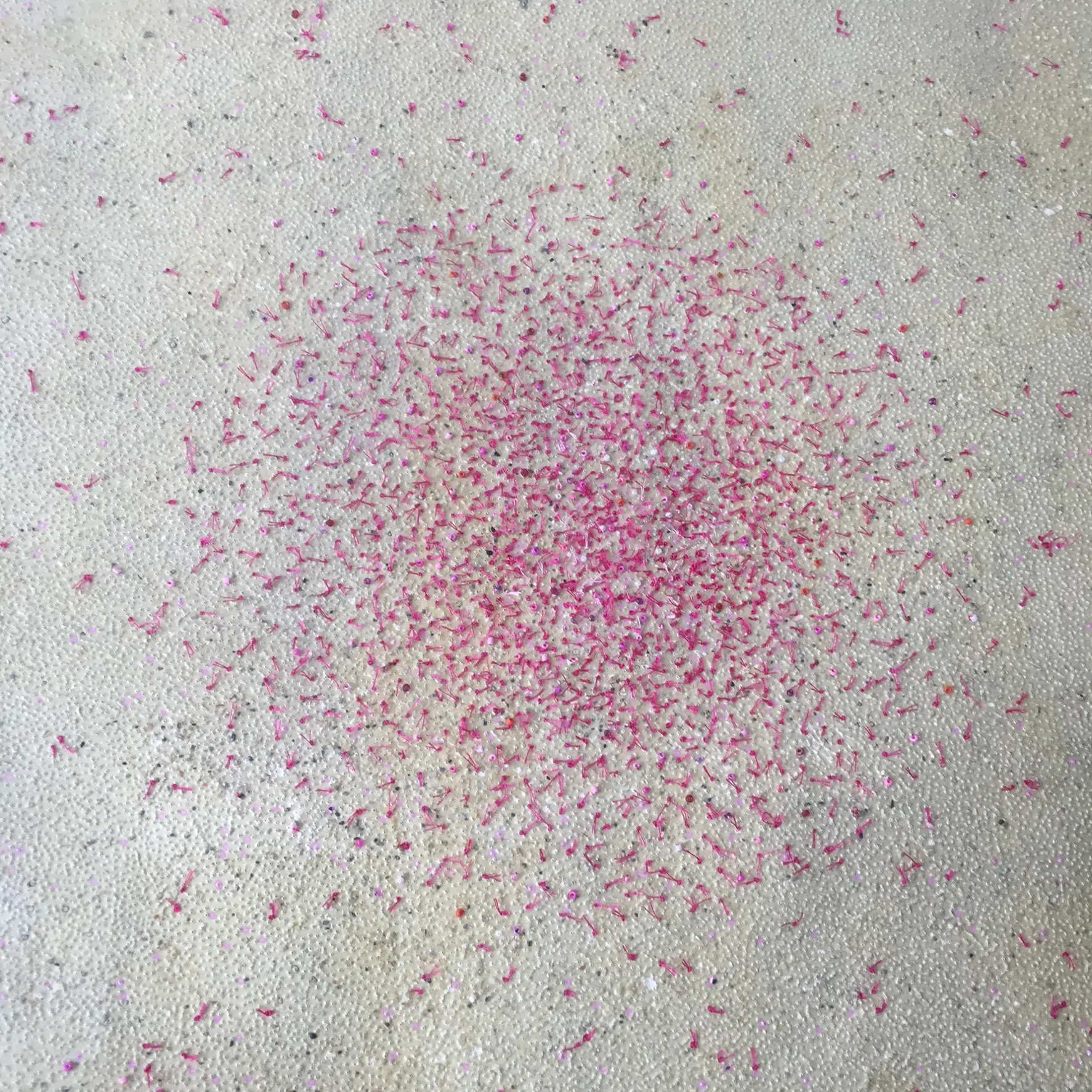
Formal and random patterns
Hilary Ellis: My work is always on paper and I use thread to build up surface texture. Usually, the stitching is used in conjunction with other media.
In ‘Raw 2017’ (pictured above) the background is built up of graphite and paint and then overlaid with a fairly thick thread which is threaded through the work loosely. It’s then tied with knots. I was trying to achieve an all over texture which is unstructured but still gives unity to the work.
I often use knotted thread in a grid-like structure as in ‘White Knots’ (pictured above). The background of this work is a collograph of a piece of fine netting which is printed in black ink. The knots were worked in a grid-like pattern on the surface. I like the way the threads find their own direction in which to settle, creating an interplay between the structured grid pattern and the randomness of the knots.
In ‘Pink Swarm’ (pictured above) very small stitches and French knots are used to create the feeling of small insects massing together. Perforations are also used to help create this effect.
Generally, I use thread to give my work more of a three-dimensional appearance. Usually, this is by means of knots, either used in a formal pattern or more randomly to provide points of interest.
Website: hilaryellis.co.uk
Read TextileArtist.org’s interview with Hilary
Karen Henderson
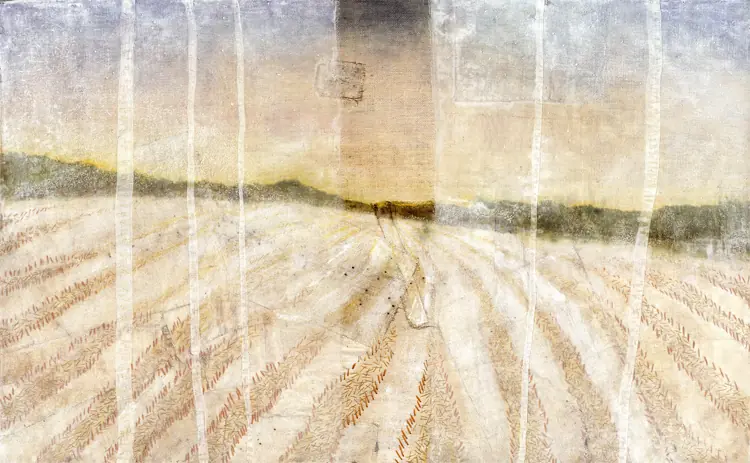
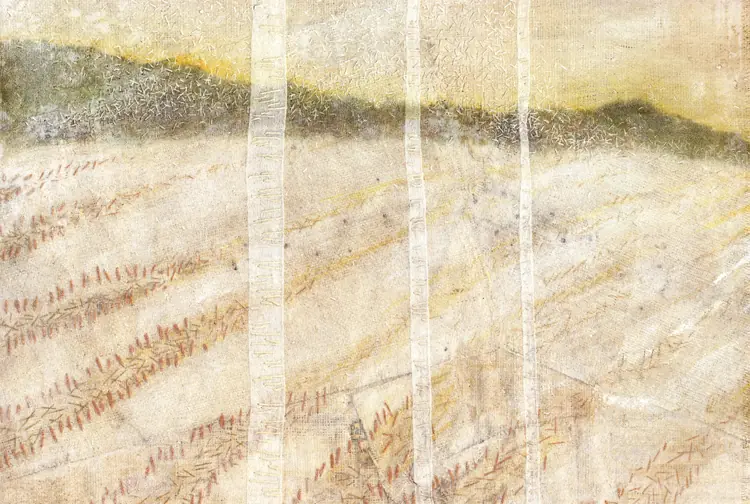
Endless variations of simple stitches
Karen Henderson: I use mainly seed stitch and running stitch to develop areas of texture. There are endless variations within those stitches that allow for different effects. Smaller size stitches, thickness of thread, type of thread (shiny like metallics or rayon, or matte like cotton or hemp), density or layering of the stitching.
Most times, I’m not using stitches to create the actual imagery, but to add texture or atmosphere to support whatever concept I’m working with.
‘Early Winter’ (pictured above) mainly uses a small seed stitch. First in the sky area for movement of snow or fog, and then in the rows of field grass. In those areas, the stitch is used more like vertical slashes that change in scale as they go back in the distance.
There is also a wider horizontal stitch used in the vertical areas of folded silk gauze to add texture to the trees.
This piece is made up of a found vintage fabric that I dyed, painted, layered with silk gauze, and stitched both behind the gauze and on top of it.
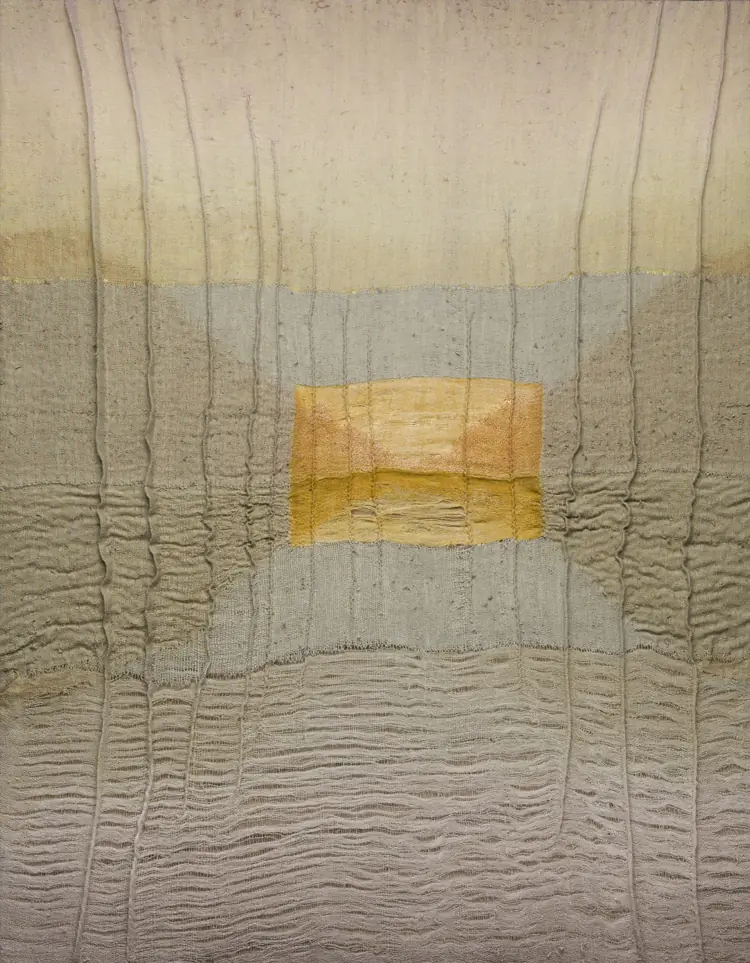
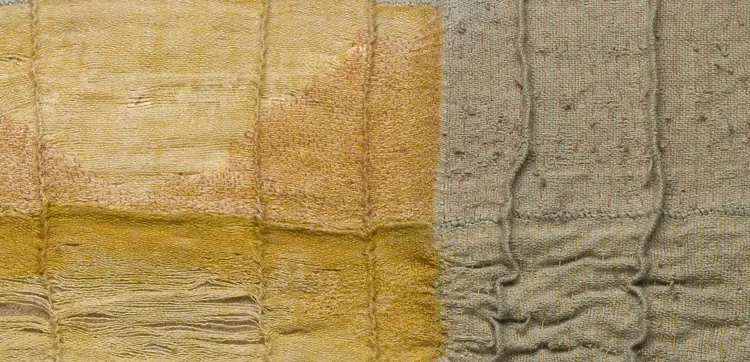
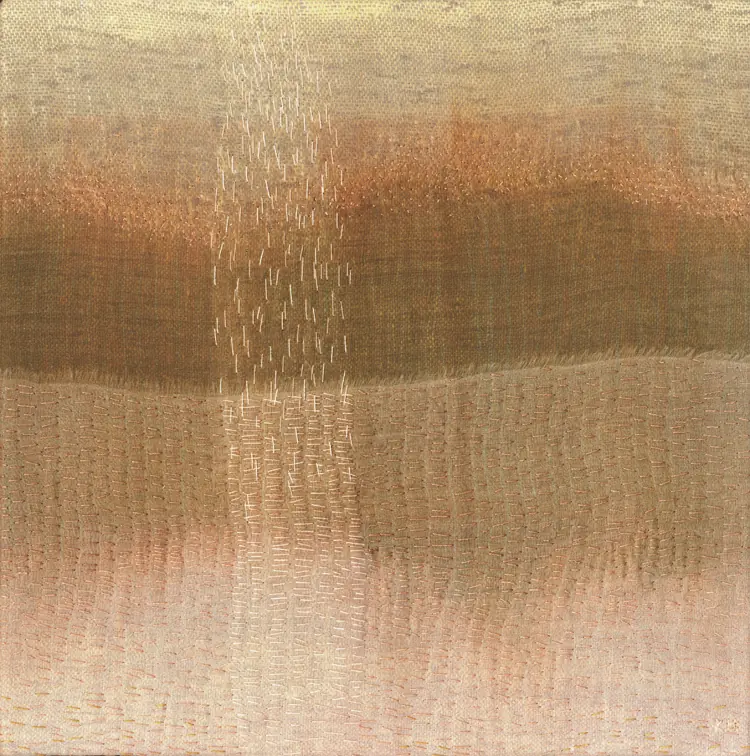
Enjoying the rhythm of stitch
For the piece ‘Choice’ (pictured above) I used only running stitch. Some stitches are spaced wide, some tighter. I also used the same stitch to create the tucks, with varying tension which created movement. The piece is handwoven, with linen as the warp and a pineapple ramie and silk/stainless steel for the weft. After weaving, I dyed it, layered it over other dyed or metallic fabrics, and then did the stitching.
Lately, I’ve been using plain stitches that are fairly long, either vertically or horizontally. The horizontal stitch I use often when I’m working with water concepts. It’s sort of literal I suppose, but I enjoy the rhythm this stitch creates when it’s used lightly or densely layered. The vertical stitch I’m using to indicate light or a change in atmosphere.
One piece that uses both of these, along with some seed stitch, is ‘Beaming’ (pictured above). This piece is hand woven linen and silk, which was dyed. The stitching I hope captures a moment of light over water.
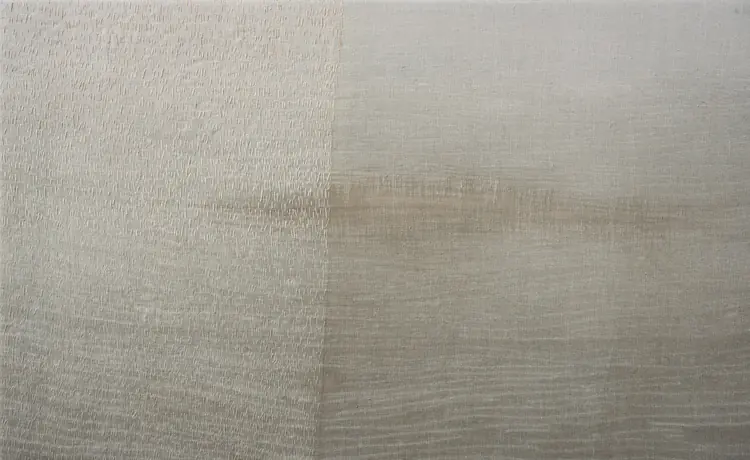
Textural juxtaposition
Another recent way I’ve been working with this longer vertical stitch is using them in rows. ‘Memory of Possibility’ (pictured above) is from a series I’m calling ‘Islands for Sale’, inspired by memories of childhood camping trips to Canada where, when boating, we would see little islands with ‘For Sale’ signs that I so badly wished to buy. Night fishing was also something we did on those trips and I loved the light at the end of the day, just before dark.
The vertical stitches gradate very slightly in color, and I hope to create the feeling of fog, movement, and that changing time of day with the texture. I like how the stitch is juxtaposed with the non-stitched but shibori dyed hemp fabric that is the base.
Website: karenhendersonfiber.com
Read TextileArtist.org’s interview with Karen
How do you use embroidery to create texture and pattern in your work? Let us know in the comments section below.
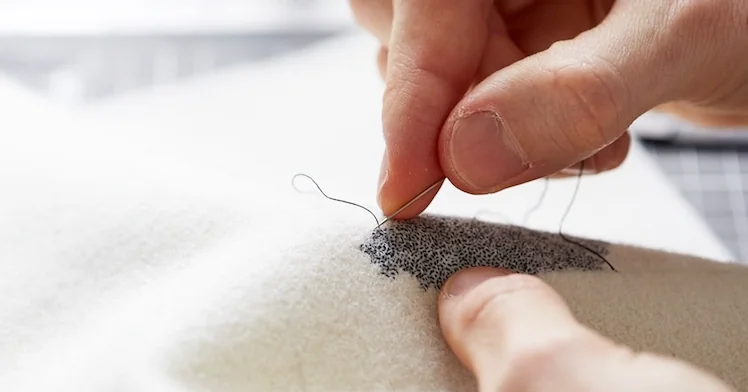

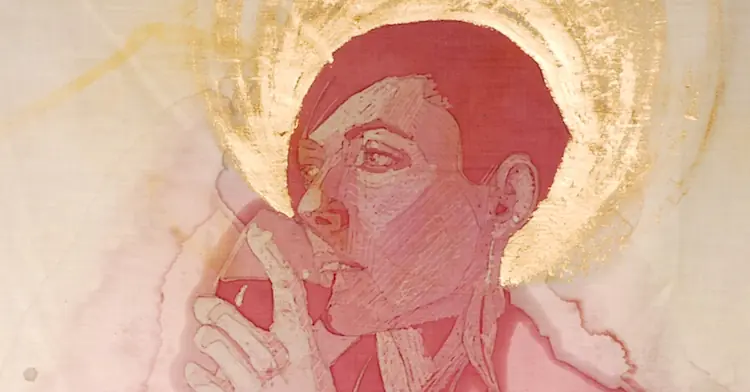
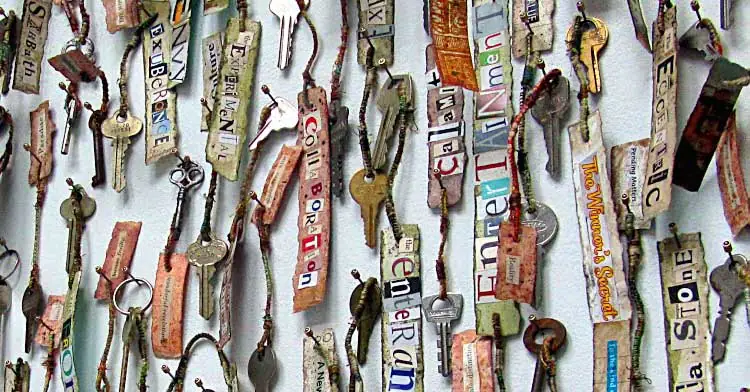
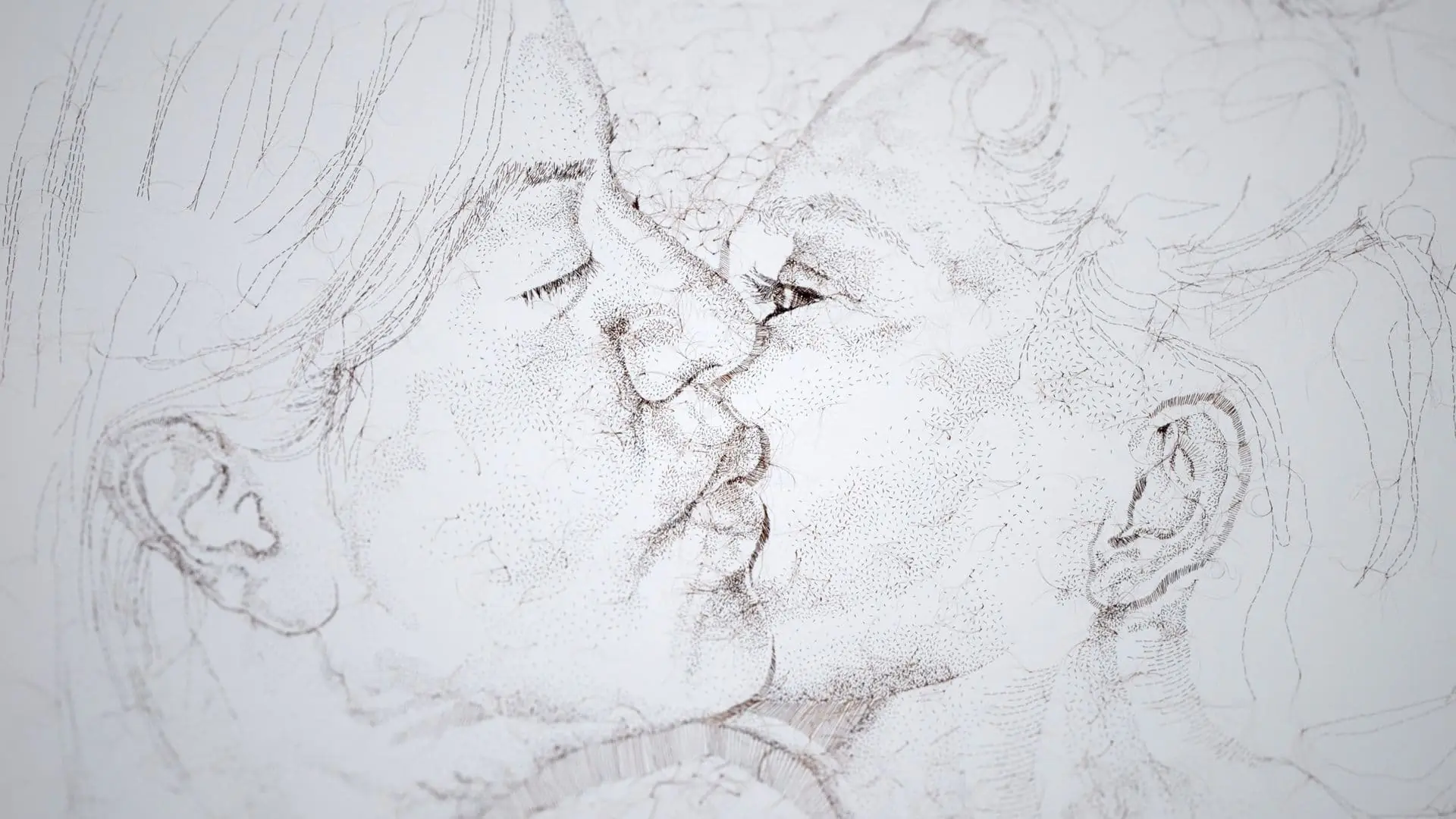
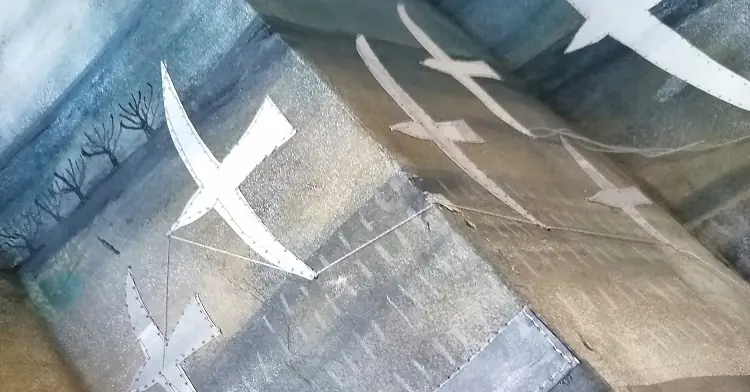
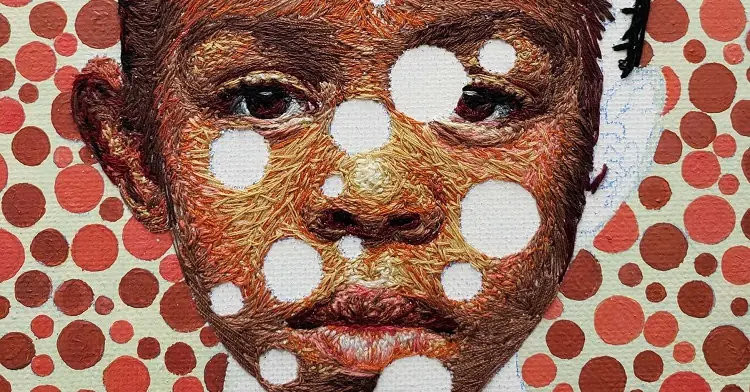
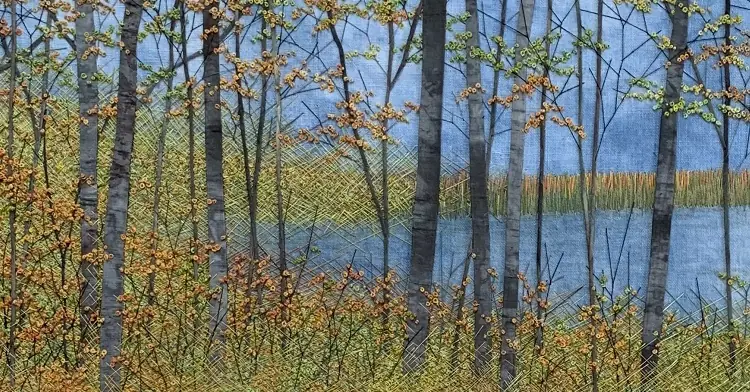
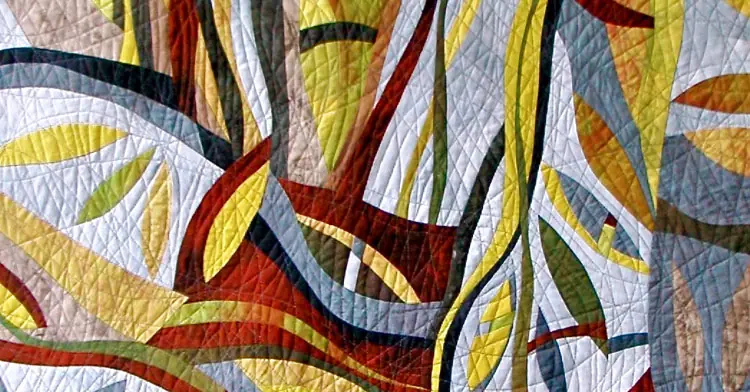
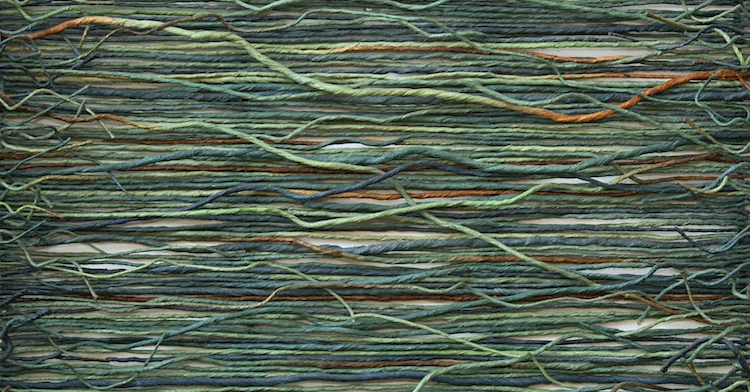
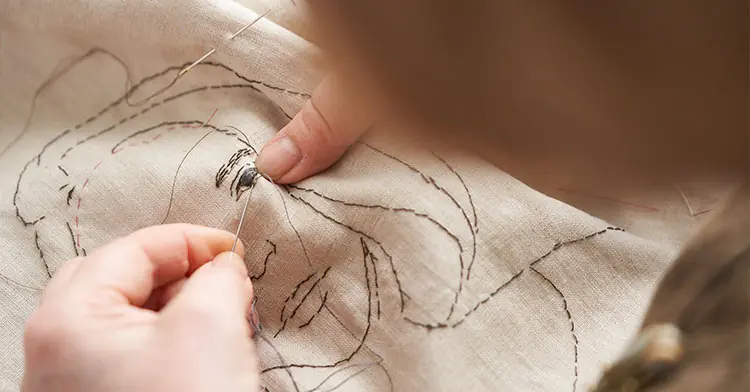
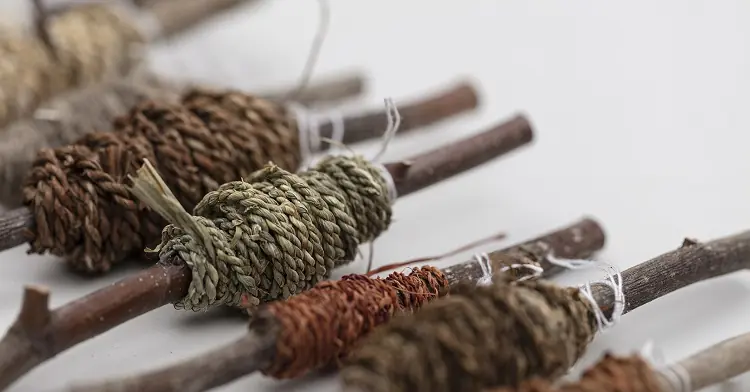
2 comments
Alison Schwabe
Hillary Ennis’ “White Knots” reminds me so much of a recent experiment I did trying out AI for potential – I gave it the photo of the BACK side of a work, and it generated a pattern not unlike White knots – I blogged about it https://www.alisonschwabe.com/weblog/?p=9371 An excellent article, reinforcing what I have long believed, that you really only need to know one basic stitch, the Glorious Straight Stitch, as I think of it. Well, French Knots and stemmed French Knots, are totally essential to me, too. Excellent article, well chosen examples.
Cheers Alison
Siân Goff
Hi Alison, thank you so much for your comment. I’m glad you enjoyed the article. It’s interesting to hear about you AI experiments! Happy Stitching!